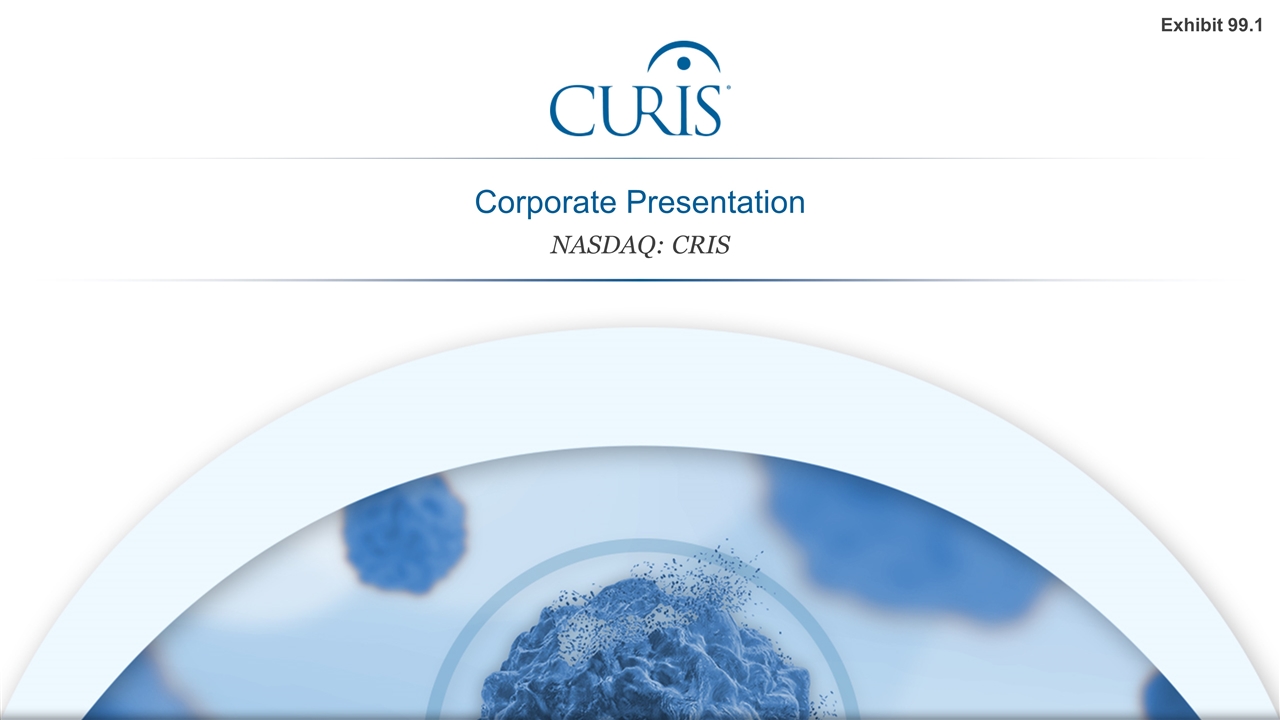
Corporate Presentation NASDAQ: CRIS Exhibit 99.1
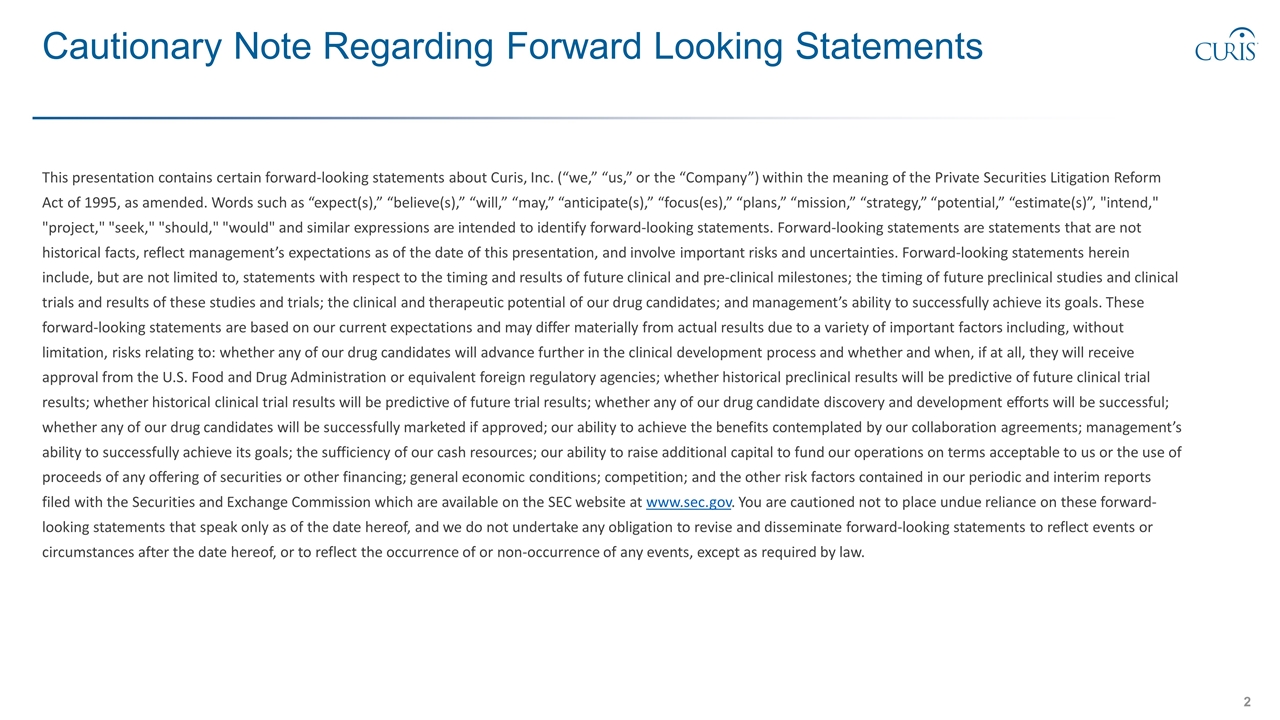
Cautionary Note Regarding Forward Looking Statements This presentation contains certain forward-looking statements about Curis, Inc. (“we,” “us,” or the “Company”) within the meaning of the Private Securities Litigation Reform Act of 1995, as amended. Words such as “expect(s),” “believe(s),” “will,” “may,” “anticipate(s),” “focus(es),” “plans,” “mission,” “strategy,” “potential,” “estimate(s)”, "intend," "project," "seek," "should," "would" and similar expressions are intended to identify forward-looking statements. Forward-looking statements are statements that are not historical facts, reflect management’s expectations as of the date of this presentation, and involve important risks and uncertainties. Forward-looking statements herein include, but are not limited to, statements with respect to the timing and results of future clinical and pre-clinical milestones; the timing of future preclinical studies and clinical trials and results of these studies and trials; the clinical and therapeutic potential of our drug candidates; and management’s ability to successfully achieve its goals. These forward-looking statements are based on our current expectations and may differ materially from actual results due to a variety of important factors including, without limitation, risks relating to: whether any of our drug candidates will advance further in the clinical development process and whether and when, if at all, they will receive approval from the U.S. Food and Drug Administration or equivalent foreign regulatory agencies; whether historical preclinical results will be predictive of future clinical trial results; whether historical clinical trial results will be predictive of future trial results; whether any of our drug candidate discovery and development efforts will be successful; whether any of our drug candidates will be successfully marketed if approved; our ability to achieve the benefits contemplated by our collaboration agreements; management’s ability to successfully achieve its goals; the sufficiency of our cash resources; our ability to raise additional capital to fund our operations on terms acceptable to us or the use of proceeds of any offering of securities or other financing; general economic conditions; competition; and the other risk factors contained in our periodic and interim reports filed with the Securities and Exchange Commission which are available on the SEC website at www.sec.gov. You are cautioned not to place undue reliance on these forward-looking statements that speak only as of the date hereof, and we do not undertake any obligation to revise and disseminate forward-looking statements to reflect events or circumstances after the date hereof, or to reflect the occurrence of or non-occurrence of any events, except as required by law.
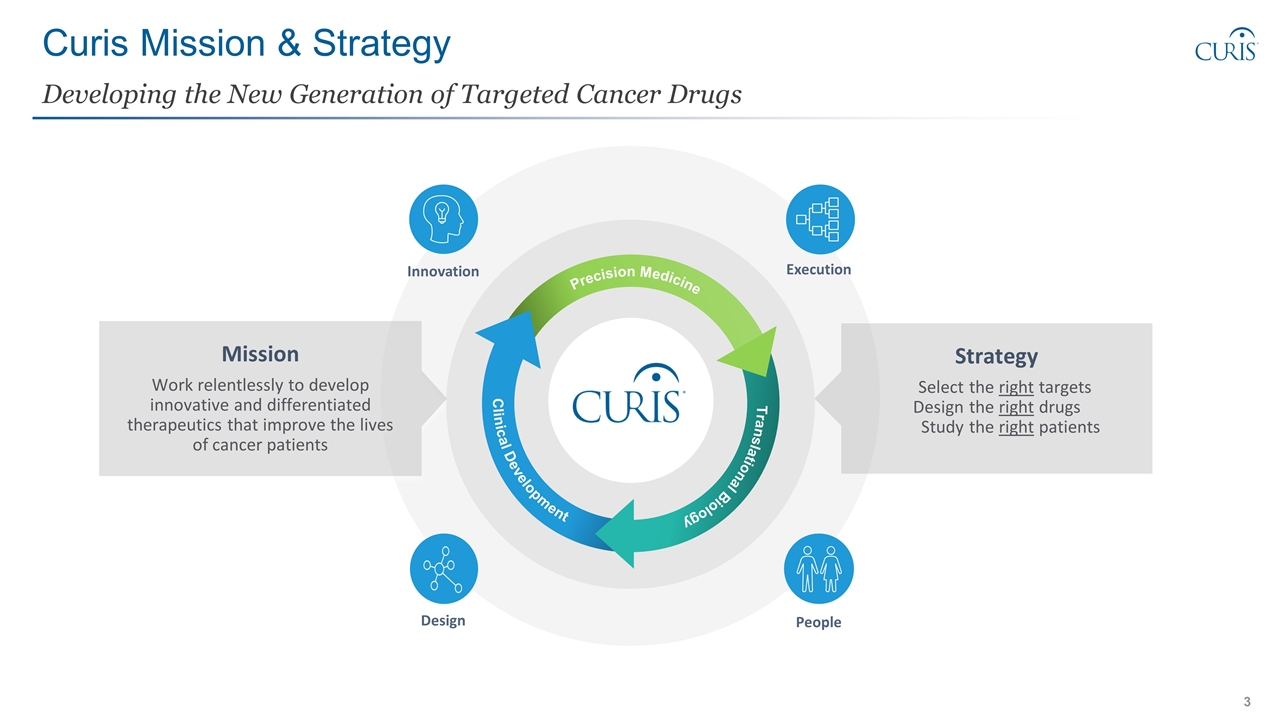
Curis Mission & Strategy Developing the New Generation of Targeted Cancer Drugs Translational Biology Clinical Development Mission Work relentlessly to develop innovative and differentiated therapeutics that improve the lives of cancer patients Strategy Selectthe right targets Designthe right drugs Studythe right patients Design Execution Innovation People Precision Medicine
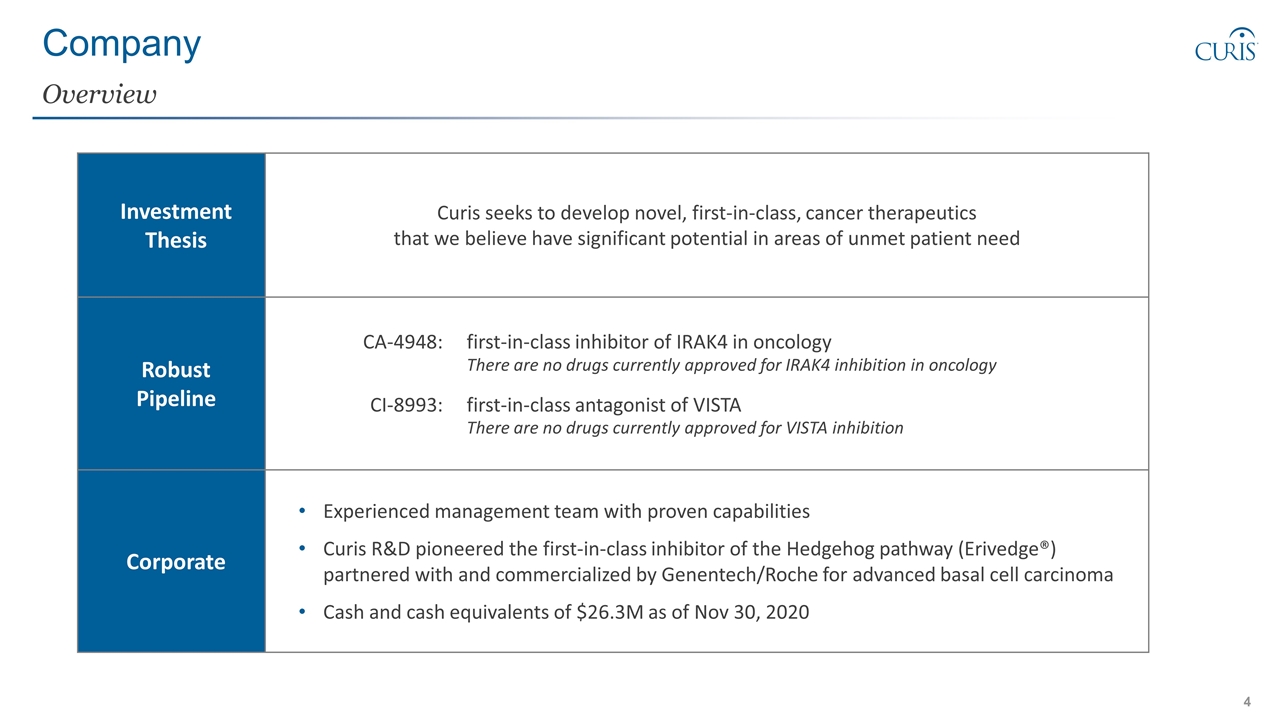
Company Overview Investment Thesis Curis seeks to develop novel, first-in-class, cancer therapeutics that we believe have significant potential in areas of unmet patient need Robust Pipeline CA-4948:first-in-class inhibitor of IRAK4 in oncology There are no drugs currently approved for IRAK4 inhibition in oncology CI-8993:first-in-class antagonist of VISTA There are no drugs currently approved for VISTA inhibition Corporate Experienced management team with proven capabilities Curis R&D pioneered the first-in-class inhibitor of the Hedgehog pathway (Erivedge®) partnered with and commercialized by Genentech/Roche for advanced basal cell carcinoma Cash and cash equivalents of $26.3M as of Nov 30, 2020
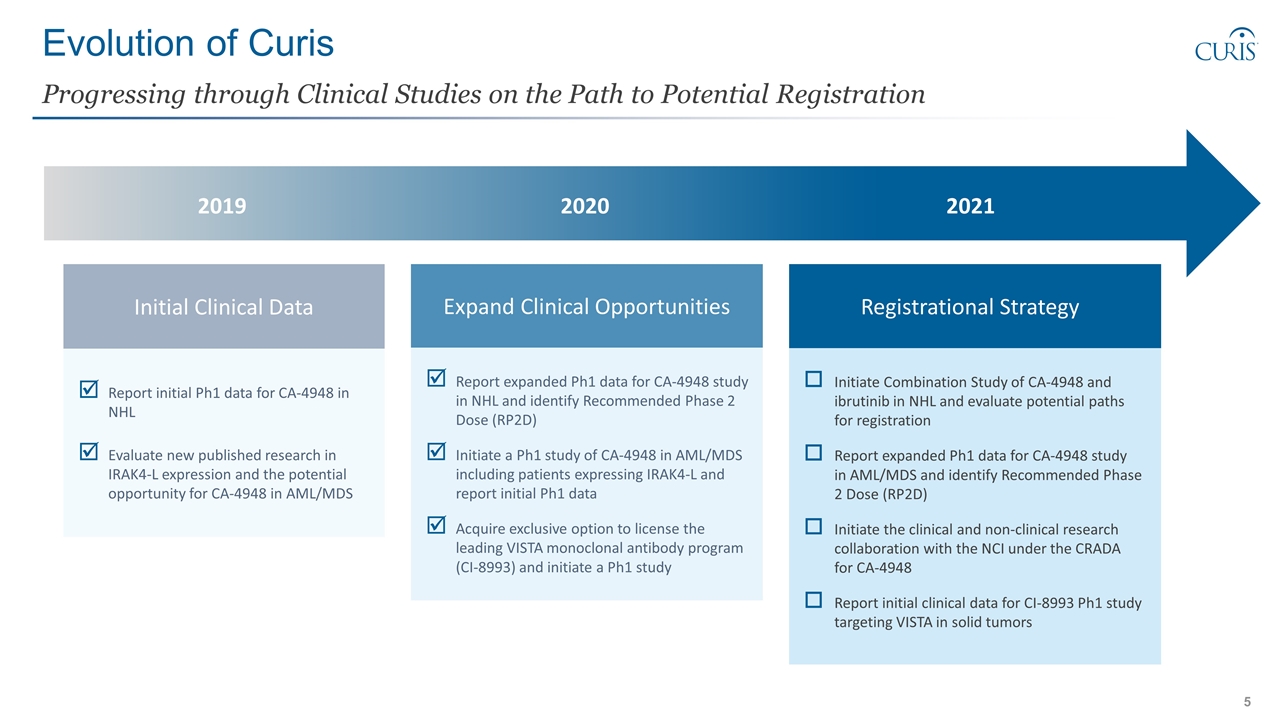
Evolution of Curis Progressing through Clinical Studies on the Path to Potential Registration Registrational Strategy Initiate Combination Study of CA-4948 and ibrutinib in NHL and evaluate potential paths for registration Report expanded Ph1 data for CA-4948 study in AML/MDS and identify Recommended Phase 2 Dose (RP2D) Initiate the clinical and non-clinical research collaboration with the NCI under the CRADA for CA-4948 Report initial clinical data for CI-8993 Ph1 study targeting VISTA in solid tumors 2019 2020 2021 Expand Clinical Opportunities Report expanded Ph1 data for CA-4948 study in NHL and identify Recommended Phase 2 Dose (RP2D) Initiate a Ph1 study of CA-4948 in AML/MDS including patients expressing IRAK4-L and report initial Ph1 data Acquire exclusive option to license the leading VISTA monoclonal antibody program (CI-8993) and initiate a Ph1 study Initial Clinical Data Report initial Ph1 data for CA-4948 in NHL Evaluate new published research in IRAK4-L expression and the potential opportunity for CA-4948 in AML/MDS
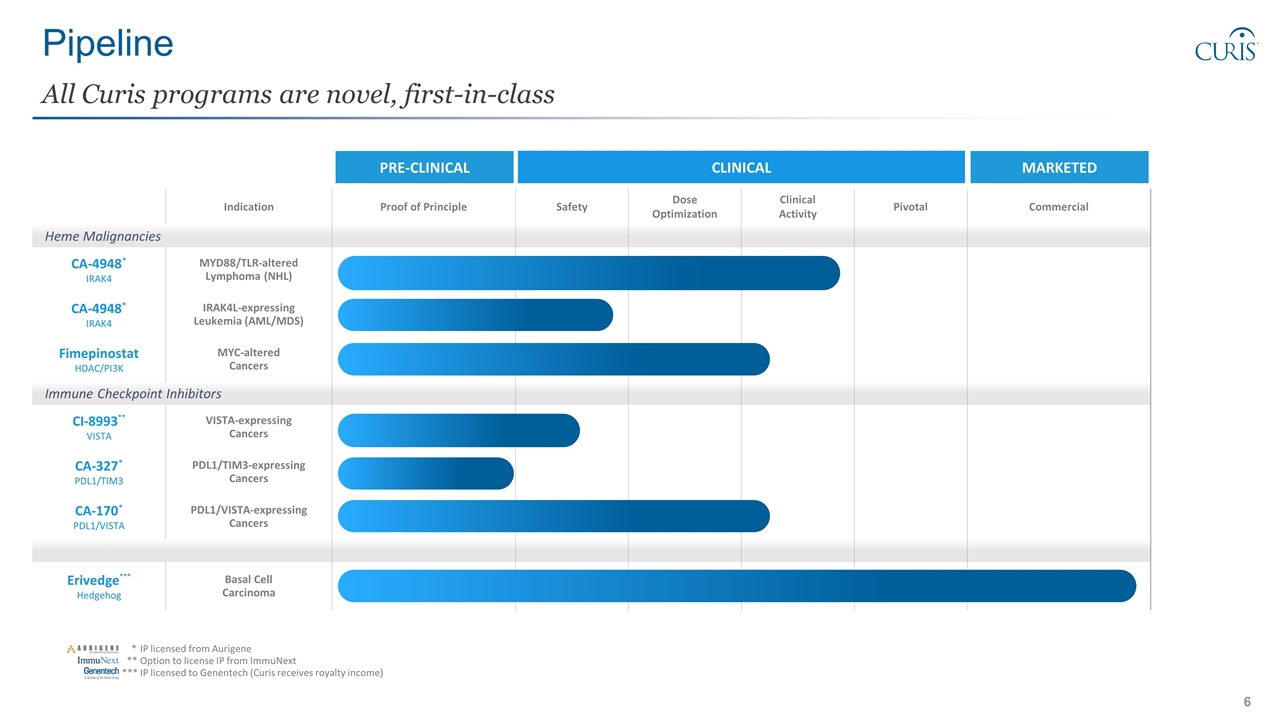
Indication Proof of Principle Safety Dose Optimization Clinical Activity Pivotal Commercial Heme Malignancies CA-4948* IRAK4 MYD88/TLR-altered Lymphoma (NHL) CA-4948* IRAK4 IRAK4L-expressing Leukemia (AML/MDS) Fimepinostat HDAC/PI3K MYC-altered Cancers Immune Checkpoint Inhibitors CI-8993** VISTA VISTA-expressing Cancers CA-327* PDL1/TIM3 PDL1/TIM3-expressing Cancers CA-170* PDL1/VISTA PDL1/VISTA-expressing Cancers Approved Drug Erivedge*** Hedgehog Basal Cell Carcinoma Pipeline All Curis programs are novel, first-in-class CLINICAL MARKETED *IP licensed from Aurigene **Option to license IP from ImmuNext ***IP licensed to Genentech (Curis receives royalty income) 6 PRE-CLINICAL
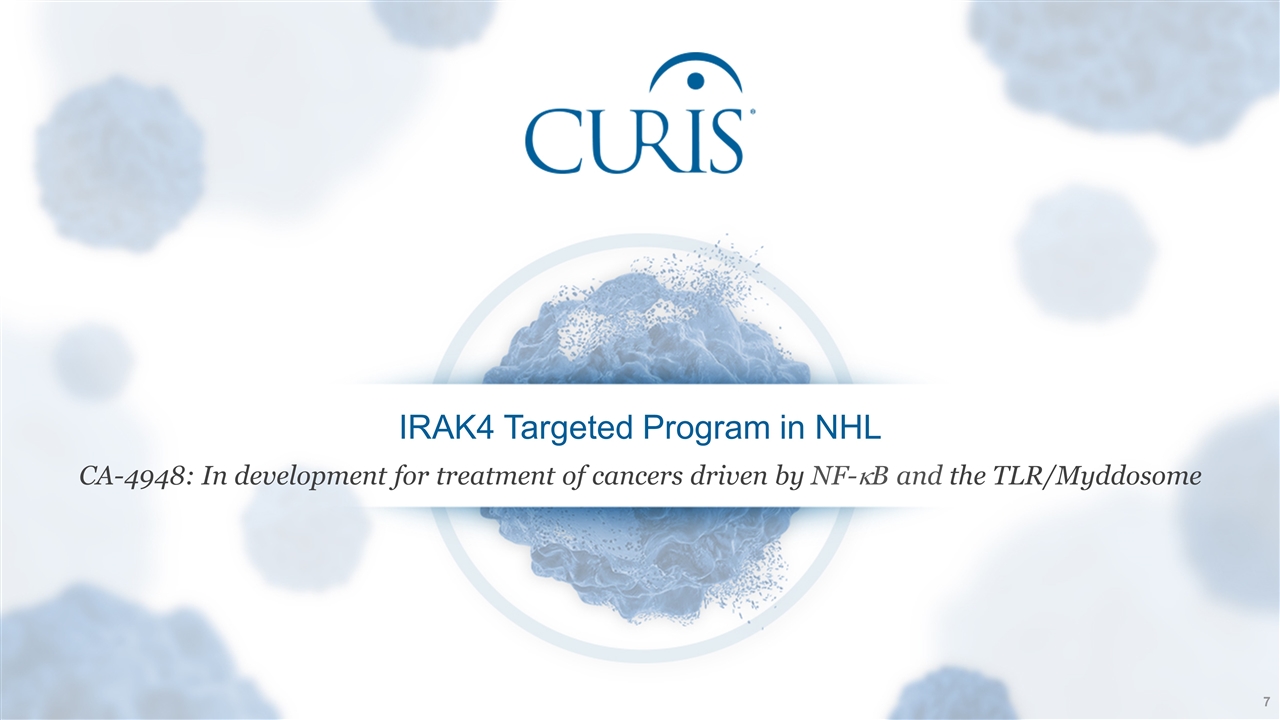
IRAK4 Targeted Program in NHL CA-4948: In development for treatment of cancers driven by NF-kB and the TLR/Myddosome
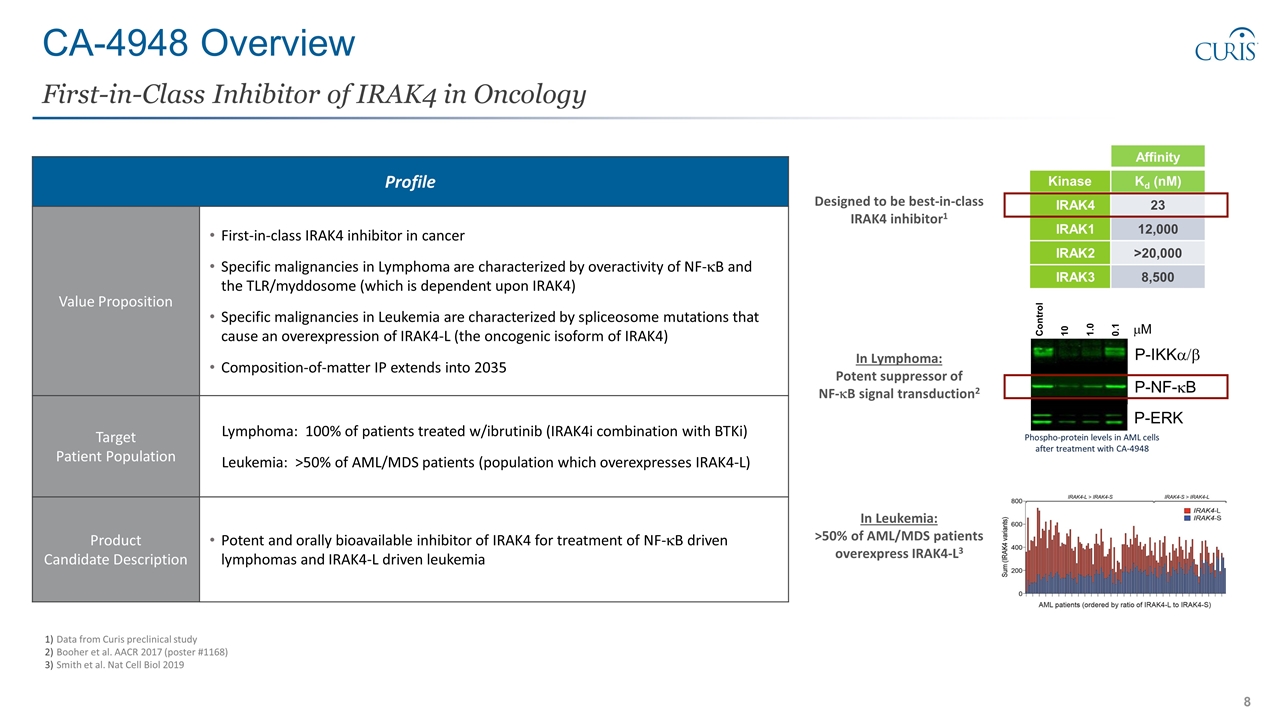
CA-4948 Overview Data from Curis preclinical study Booher et al. AACR 2017 (poster #1168) Smith et al. Nat Cell Biol 2019 Profile Value Proposition First-in-class IRAK4 inhibitor in cancer Specific malignancies in Lymphoma are characterized by overactivity of NF-kB and the TLR/myddosome (which is dependent upon IRAK4) Specific malignancies in Leukemia are characterized by spliceosome mutations that cause an overexpression of IRAK4-L (the oncogenic isoform of IRAK4) Composition-of-matter IP extends into 2035 Target Patient Population Lymphoma: 100% of patients treated w/ibrutinib (IRAK4i combination with BTKi) Leukemia: >50% of AML/MDS patients (population which overexpresses IRAK4-L) Product Candidate Description Potent and orally bioavailable inhibitor of IRAK4 for treatment of NF-kB driven lymphomas and IRAK4-L driven leukemia In Lymphoma: Potent suppressor of NF-kB signal transduction2 Phospho-protein levels in AML cells after treatment with CA-4948 Affinity Kinase Kd (nM) IRAK4 23 IRAK1 12,000 IRAK2 >20,000 IRAK3 8,500 Designed to be best-in-class IRAK4 inhibitor1 First-in-Class Inhibitor of IRAK4 in Oncology In Leukemia: >50% of AML/MDS patients overexpress IRAK4-L3 Unstimulated Control 10 1.0 0.1 mM P-IKKa/b P-NF-kB P-ERK
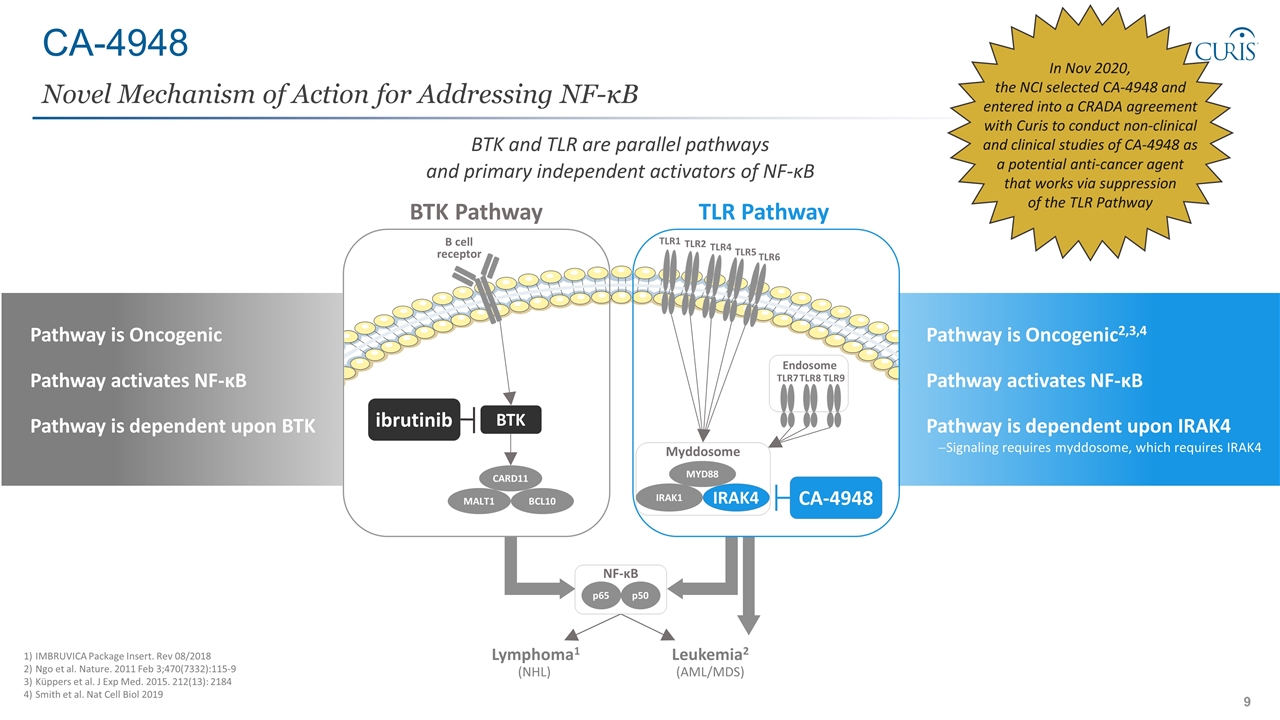
CA-4948 Novel Mechanism of Action for Addressing NF-κB Pathway is Oncogenic Pathway activates NF-κB Pathway is dependent upon BTK Pathway is Oncogenic2,3,4 Pathway activates NF-κB Pathway is dependent upon IRAK4 Signaling requires myddosome, which requires IRAK4 IMBRUVICA Package Insert. Rev 08/2018 Ngo et al. Nature. 2011 Feb 3;470(7332):115-9 Küppers et al. J Exp Med. 2015. 212(13): 2184 Smith et al. Nat Cell Biol 2019 TLR1 B cell receptor Lymphoma1 (NHL) IRAK1 BTK CARD11 MALT1 BCL10 ibrutinib TLR2 TLR4 TLR5 TLR6 TLR7 TLR8 TLR9 Myddosome MYD88 CA-4948 IRAK4 BTK Pathway TLR Pathway Leukemia2 (AML/MDS) Endosome p65 p50 NF-κB BTK and TLR are parallel pathways and primary independent activators of NF-κB In Nov 2020, the NCI selected CA-4948 and entered into a CRADA agreement with Curis to conduct non-clinical and clinical studies of CA-4948 as a potential anti-cancer agent that works via suppression of the TLR Pathway
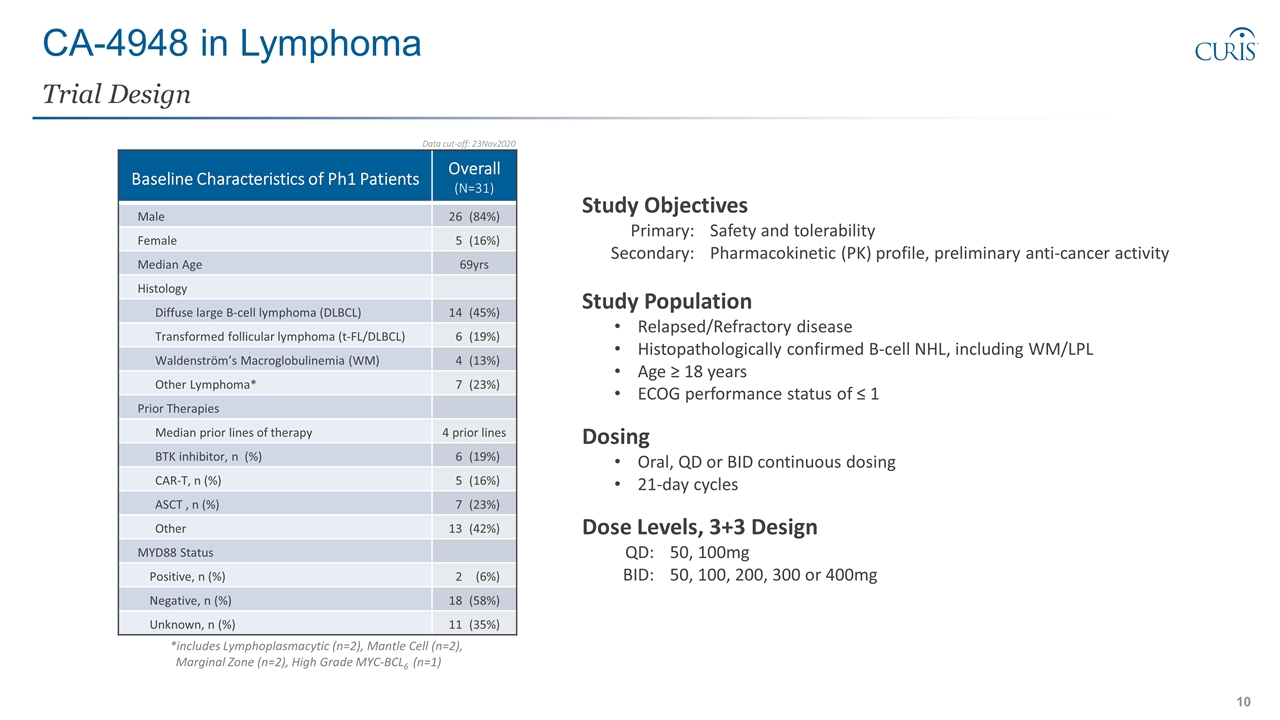
CA-4948 in Lymphoma Trial Design Study Objectives Primary: Safety and tolerability Secondary:Pharmacokinetic (PK) profile, preliminary anti-cancer activity Study Population Relapsed/Refractory disease Histopathologically confirmed B-cell NHL, including WM/LPL Age ≥ 18 years ECOG performance status of ≤ 1 Dosing Oral, QD or BID continuous dosing 21-day cycles Dose Levels, 3+3 Design QD: 50, 100mg BID: 50, 100, 200, 300 or 400mg Baseline Characteristics of Ph1 Patients Overall (N=31) Male 26(84%) Female 5(16%) Median Age 69yrs Histology Diffuse large B-cell lymphoma (DLBCL) 14(45%) Transformed follicular lymphoma (t-FL/DLBCL) 6(19%) Waldenström’s Macroglobulinemia (WM) 4(13%) Other Lymphoma* 7(23%) Prior Therapies Median prior lines of therapy 4 prior lines BTK inhibitor, n (%) 6(19%) CAR-T, n (%) 5(16%) ASCT , n (%) 7(23%) Other 13(42%) MYD88 Status Positive, n (%) 2(6%) Negative, n (%) 18(58%) Unknown, n (%) 11(35%) *includes Lymphoplasmacytic (n=2), Mantle Cell (n=2), Marginal Zone (n=2), High Grade MYC-BCL6 (n=1) Data cut-off: 23Nov2020
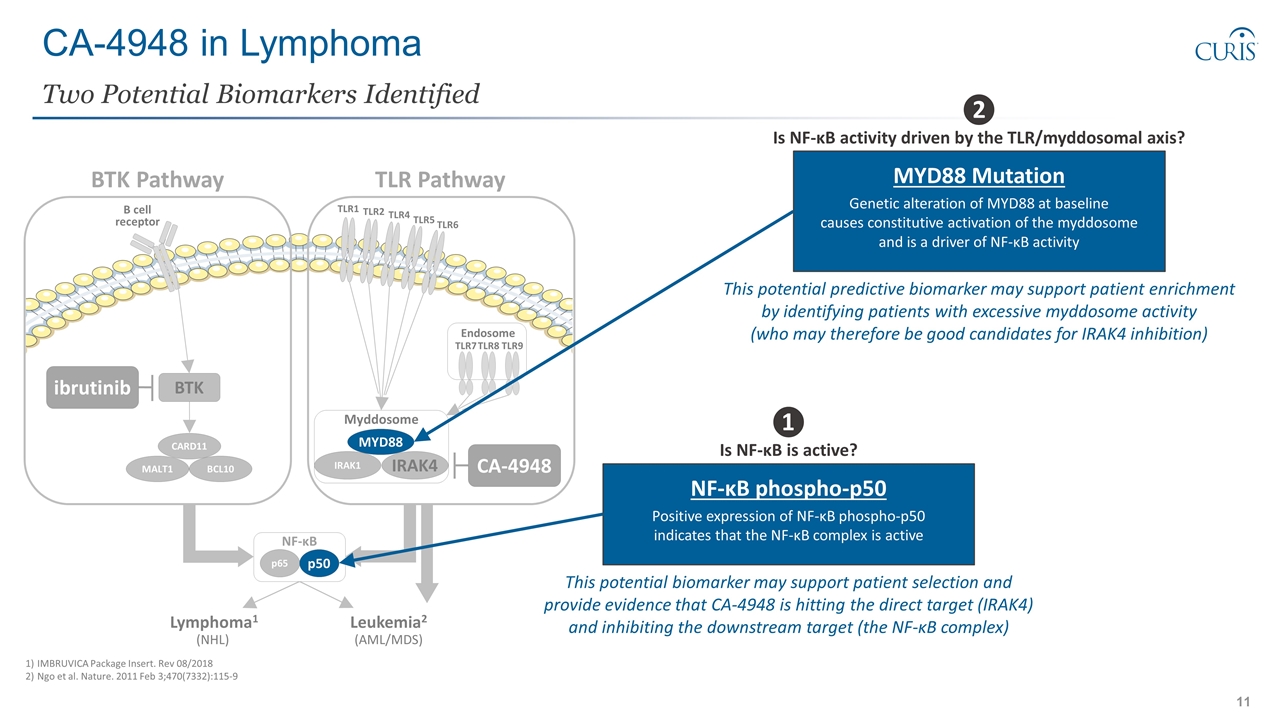
CA-4948 in Lymphoma Two Potential Biomarkers Identified NF-κB phospho-p50 Positive expression of NF-κB phospho-p50 indicates that the NF-κB complex is active MYD88 Mutation Genetic alteration of MYD88 at baseline causes constitutive activation of the myddosome and is a driver of NF-κB activity ❷ Is NF-κB activity driven by the TLR/myddosomal axis? ❶ Is NF-κB is active? TLR1 B cell receptor Lymphoma1 (NHL) IRAK1 BTK CARD11 MALT1 BCL10 ibrutinib TLR2 TLR4 TLR5 TLR6 TLR7 TLR8 TLR9 Myddosome MYD88 CA-4948 IRAK4 BTK Pathway TLR Pathway Leukemia2 (AML/MDS) Endosome p65 p50 NF-κB IMBRUVICA Package Insert. Rev 08/2018 Ngo et al. Nature. 2011 Feb 3;470(7332):115-9 This potential biomarker may support patient selection and provide evidence that CA-4948 is hitting the direct target (IRAK4) and inhibiting the downstream target (the NF-κB complex) This potential predictive biomarker may support patient enrichment by identifying patients with excessive myddosome activity (who may therefore be good candidates for IRAK4 inhibition)
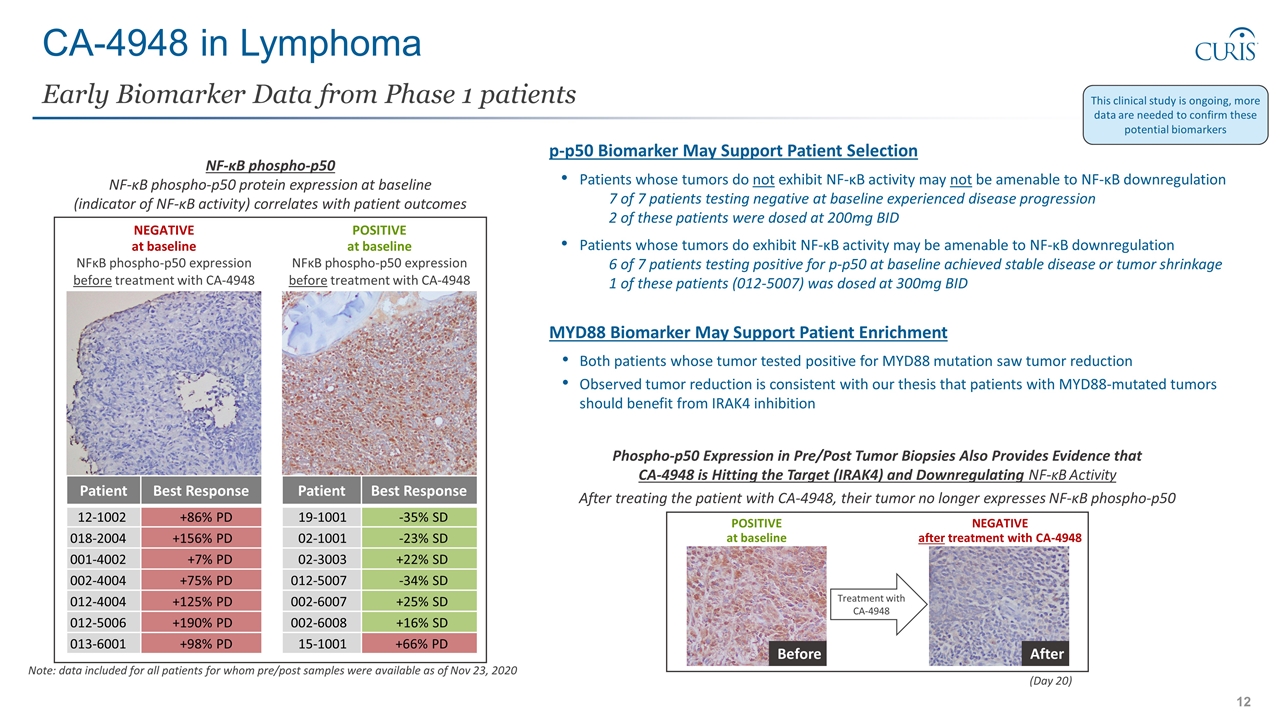
CA-4948 in Lymphoma Early Biomarker Data from Phase 1 patients Patient Best Response 12-1002 +86% PD 018-2004 +156% PD 001-4002 +7% PD 002-4004 +75% PD 012-4004 +125% PD 012-5006 +190% PD 013-6001 +98% PD NEGATIVE at baseline NFκB phospho-p50 expression before treatment with CA-4948 Patient Best Response 19-1001 -35% SD 02-1001 -23% SD 02-3003 +22% SD 012-5007 -34% SD 002-6007 +25% SD 002-6008 +16% SD 15-1001 +66% PD POSITIVE at baseline NFκB phospho-p50 expression before treatment with CA-4948 NF-κB phospho-p50 NF-κB phospho-p50 protein expression at baseline (indicator of NF-κB activity) correlates with patient outcomes Note: data included for all patients for whom pre/post samples were available as of Nov 23, 2020 Before After NEGATIVE after treatment with CA-4948 POSITIVE at baseline (Day 20) Treatment with CA-4948 Phospho-p50 Expression in Pre/Post Tumor Biopsies Also Provides Evidence that CA-4948 is Hitting the Target (IRAK4) and Downregulating NF-κB Activity After treating the patient with CA-4948, their tumor no longer expresses NF-κB phospho-p50 p-p50 Biomarker May Support Patient Selection Patients whose tumors do not exhibit NF-κB activity may not be amenable to NF-κB downregulation 7 of 7 patients testing negative at baseline experienced disease progression 2 of these patients were dosed at 200mg BID Patients whose tumors do exhibit NF-κB activity may be amenable to NF-κB downregulation 6 of 7 patients testing positive for p-p50 at baseline achieved stable disease or tumor shrinkage 1 of these patients (012-5007) was dosed at 300mg BID MYD88 Biomarker May Support Patient Enrichment Both patients whose tumor tested positive for MYD88 mutation saw tumor reduction Observed tumor reduction is consistent with our thesis that patients with MYD88-mutated tumors should benefit from IRAK4 inhibition This clinical study is ongoing, more data are needed to confirm these potential biomarkers
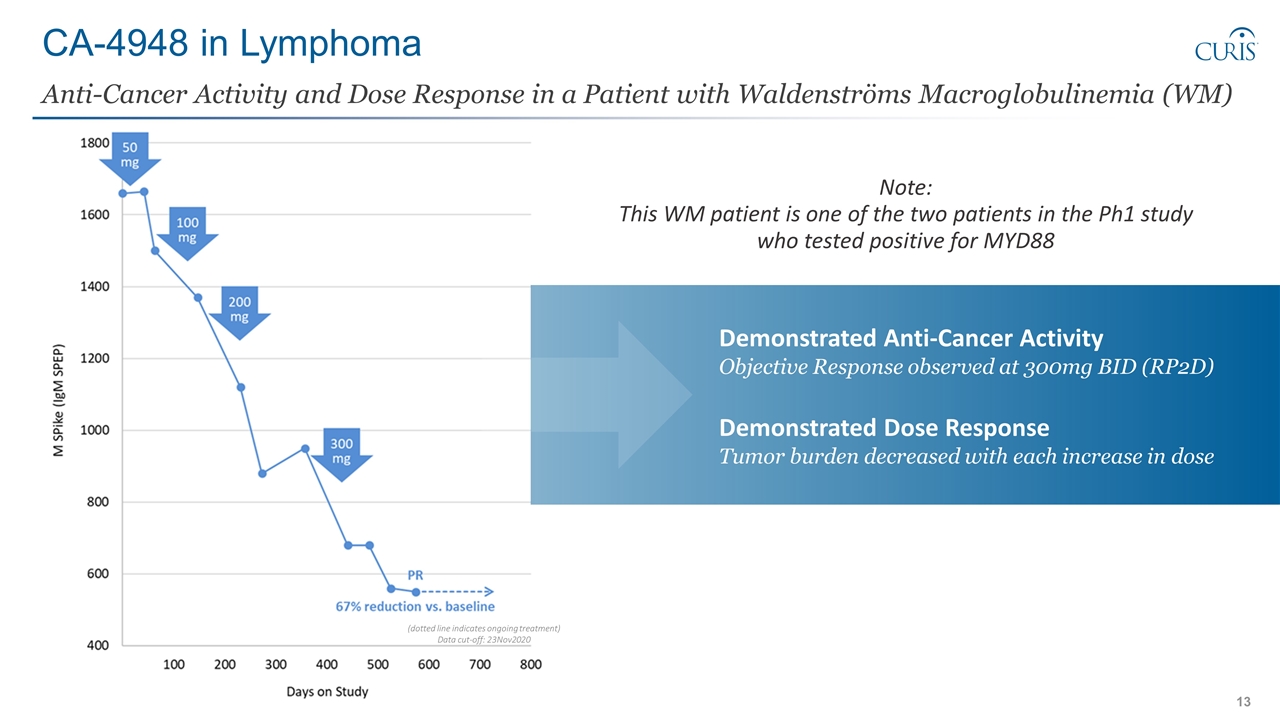
Demonstrated Anti-Cancer Activity Objective Response observed at 300mg BID (RP2D) Demonstrated Dose Response Tumor burden decreased with each increase in dose CA-4948 in Lymphoma Anti-Cancer Activity and Dose Response in a Patient with Waldenströms Macroglobulinemia (WM) Note: This WM patient is one of the two patients in the Ph1 study who tested positive for MYD88 (dotted line indicates ongoing treatment) Data cut-off: 23Nov2020
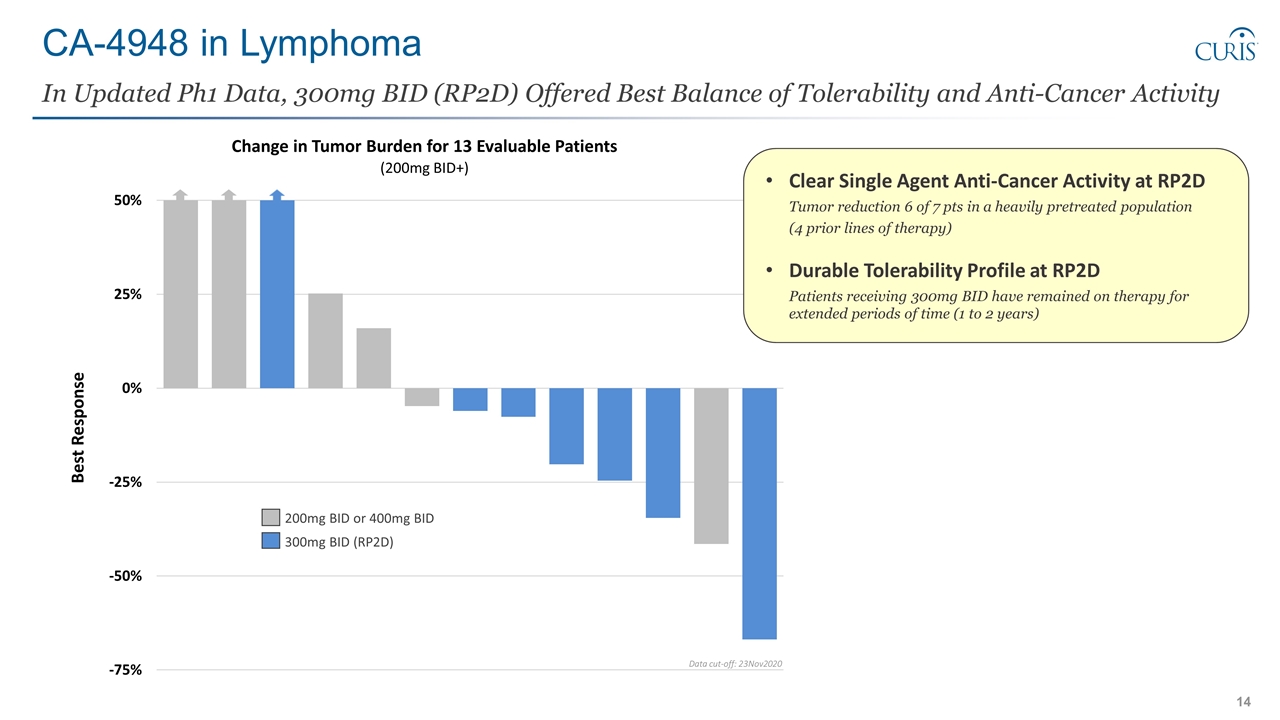
CA-4948 in Lymphoma In Updated Ph1 Data, 300mg BID (RP2D) Offered Best Balance of Tolerability and Anti-Cancer Activity 200mg BID or 400mg BID 300mg BID (RP2D) Clear Single Agent Anti-Cancer Activity at RP2D Tumor reduction 6 of 7 pts in a heavily pretreated population (4 prior lines of therapy) Durable Tolerability Profile at RP2D Patients receiving 300mg BID have remained on therapy for extended periods of time (1 to 2 years) Data cut-off: 23Nov2020
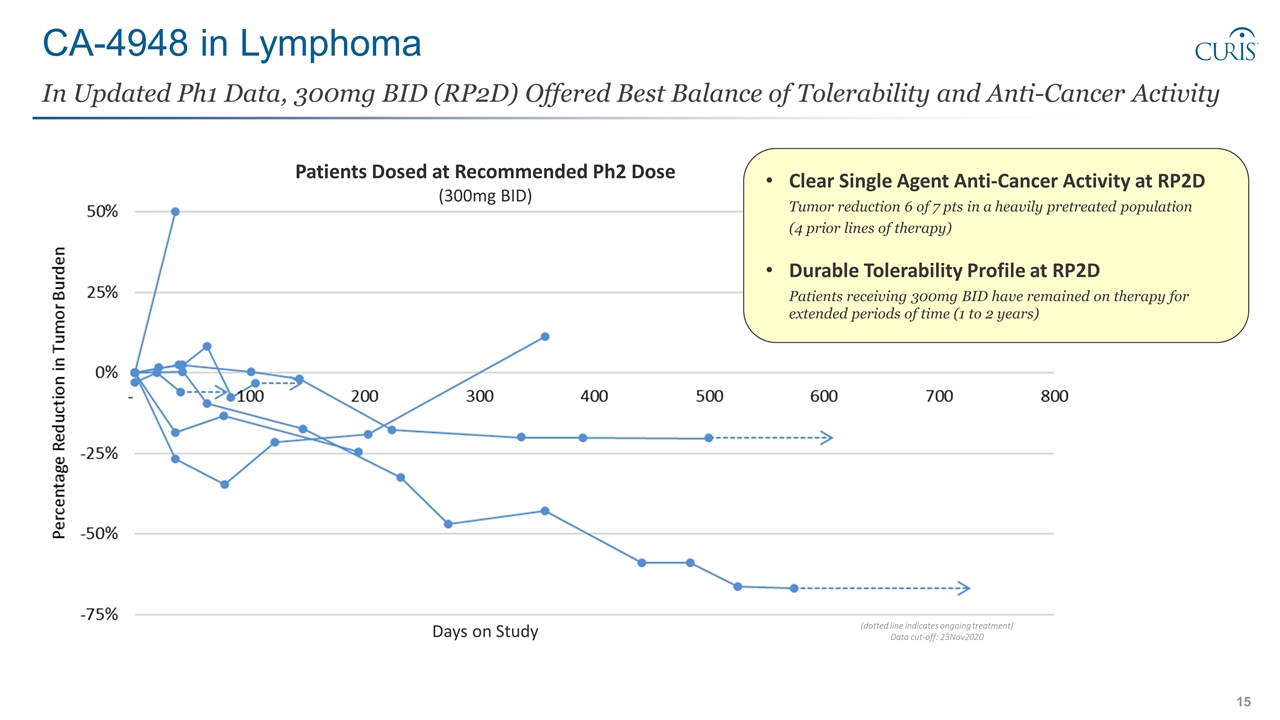
CA-4948 in Lymphoma In Updated Ph1 Data, 300mg BID (RP2D) Offered Best Balance of Tolerability and Anti-Cancer Activity Patients Dosed at Recommended Ph2 Dose (300mg BID) Days on Study (dotted line indicates ongoing treatment) Data cut-off: 23Nov2020 Clear Single Agent Anti-Cancer Activity at RP2D Tumor reduction 6 of 7 pts in a heavily pretreated population (4 prior lines of therapy) Durable Tolerability Profile at RP2D Patients receiving 300mg BID have remained on therapy for extended periods of time (1 to 2 years)
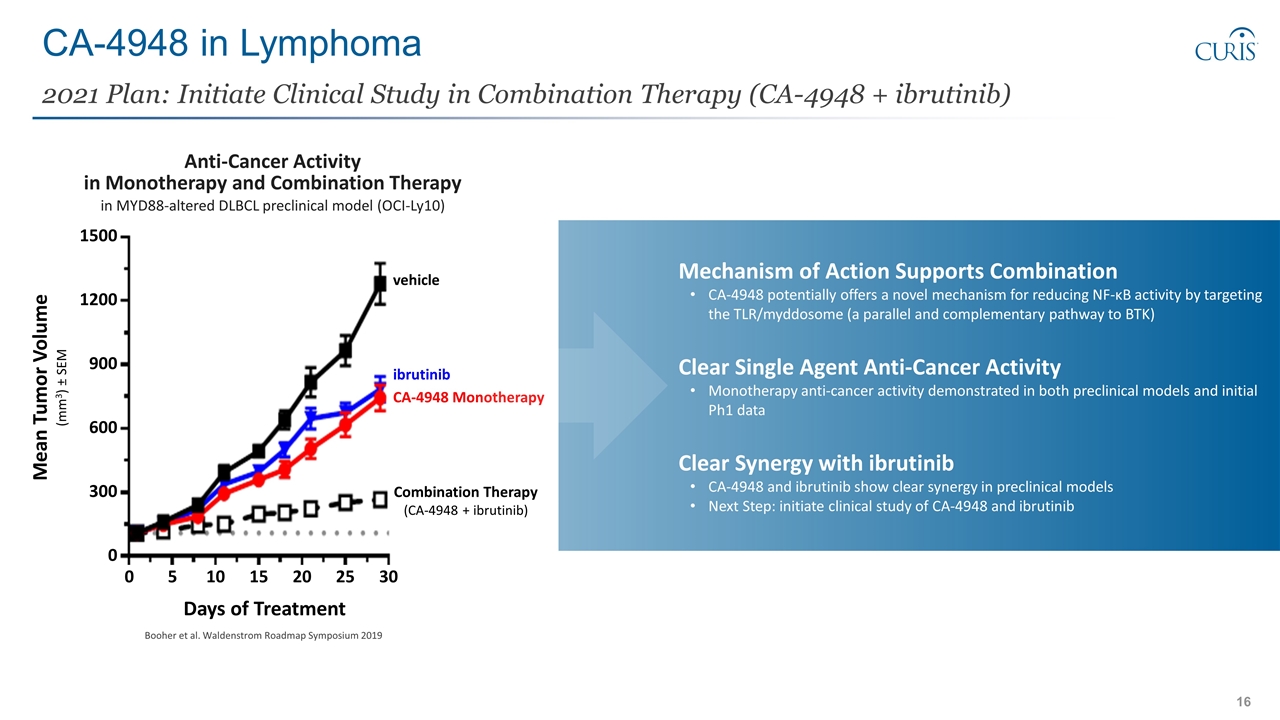
CA-4948 in Lymphoma 2021 Plan: Initiate Clinical Study in Combination Therapy (CA-4948 + ibrutinib) Days of Treatment vehicle ibrutinib Combination Therapy (CA-4948 + ibrutinib) CA-4948 Monotherapy 0 5 10 15 20 25 30 0 300 600 900 1200 1500 Mean Tumor Volume (mm3) ± SEM Anti-Cancer Activity in Monotherapy and Combination Therapy in MYD88-altered DLBCL preclinical model (OCI-Ly10) Mechanism of Action Supports Combination CA-4948 potentially offers a novel mechanism for reducing NF-κB activity by targeting the TLR/myddosome (a parallel and complementary pathway to BTK) Clear Single Agent Anti-Cancer Activity Monotherapy anti-cancer activity demonstrated in both preclinical models and initial Ph1 data Clear Synergy with ibrutinib CA-4948 and ibrutinib show clear synergy in preclinical models Next Step: initiate clinical study of CA-4948 and ibrutinib Booher et al. Waldenstrom Roadmap Symposium 2019
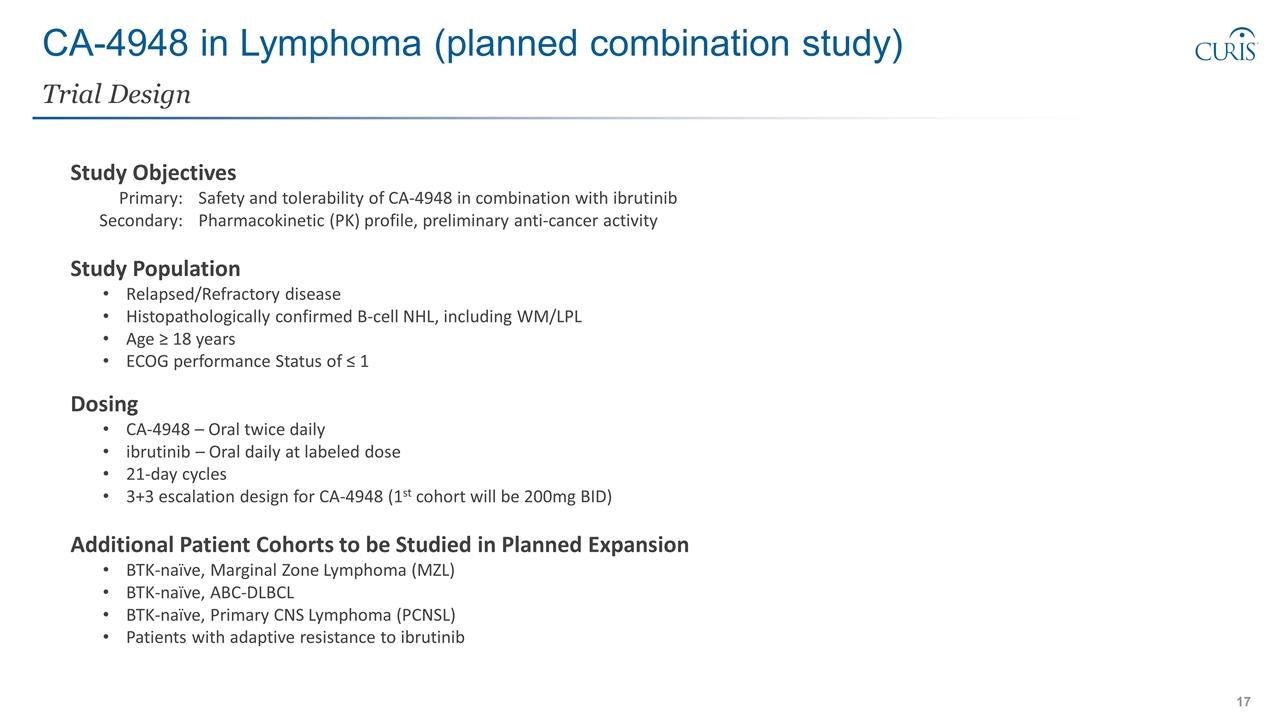
CA-4948 in Lymphoma (planned combination study) Trial Design Study Objectives Primary: Safety and tolerability of CA-4948 in combination with ibrutinib Secondary:Pharmacokinetic (PK) profile, preliminary anti-cancer activity Study Population Relapsed/Refractory disease Histopathologically confirmed B-cell NHL, including WM/LPL Age ≥ 18 years ECOG performance Status of ≤ 1 Dosing CA-4948 – Oral twice daily ibrutinib – Oral daily at labeled dose 21-day cycles 3+3 escalation design for CA-4948 (1st cohort will be 200mg BID) Additional Patient Cohorts to be Studied in Planned Expansion BTK-naïve, Marginal Zone Lymphoma (MZL) BTK-naïve, ABC-DLBCL BTK-naïve, Primary CNS Lymphoma (PCNSL) Patients with adaptive resistance to ibrutinib
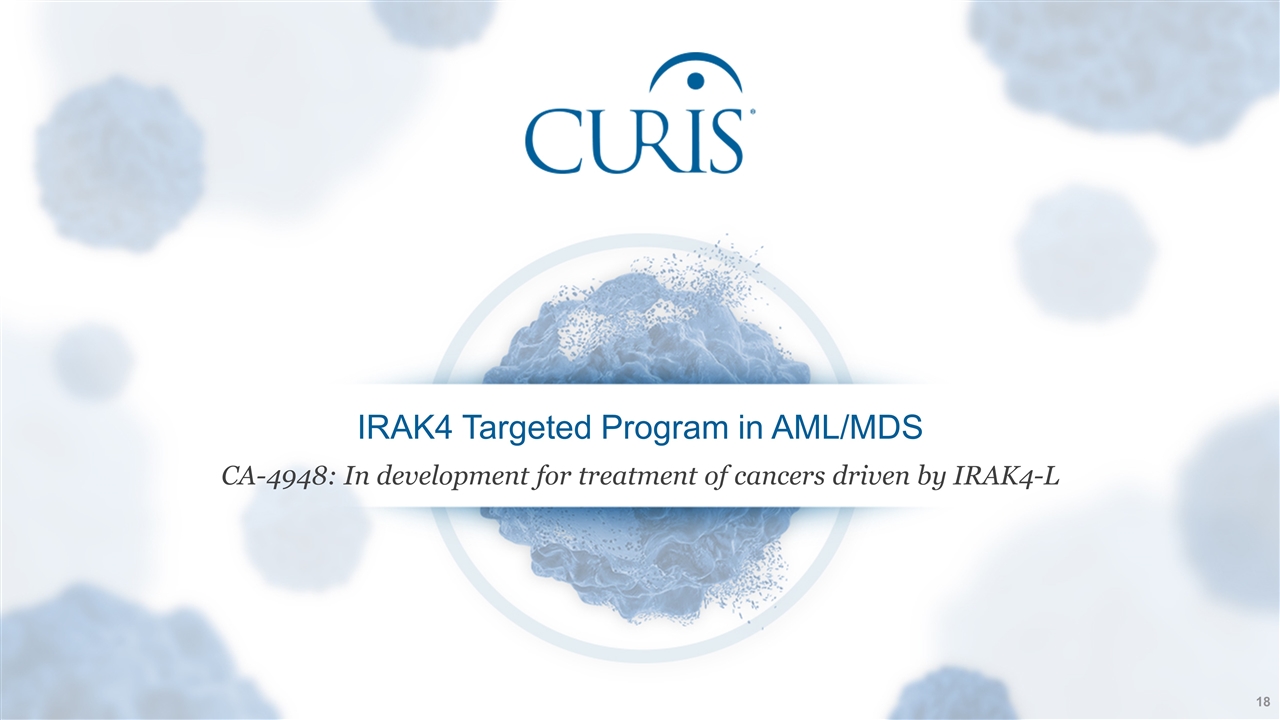
IRAK4 Targeted Program in AML/MDS CA-4948: In development for treatment of cancers driven by IRAK4-L
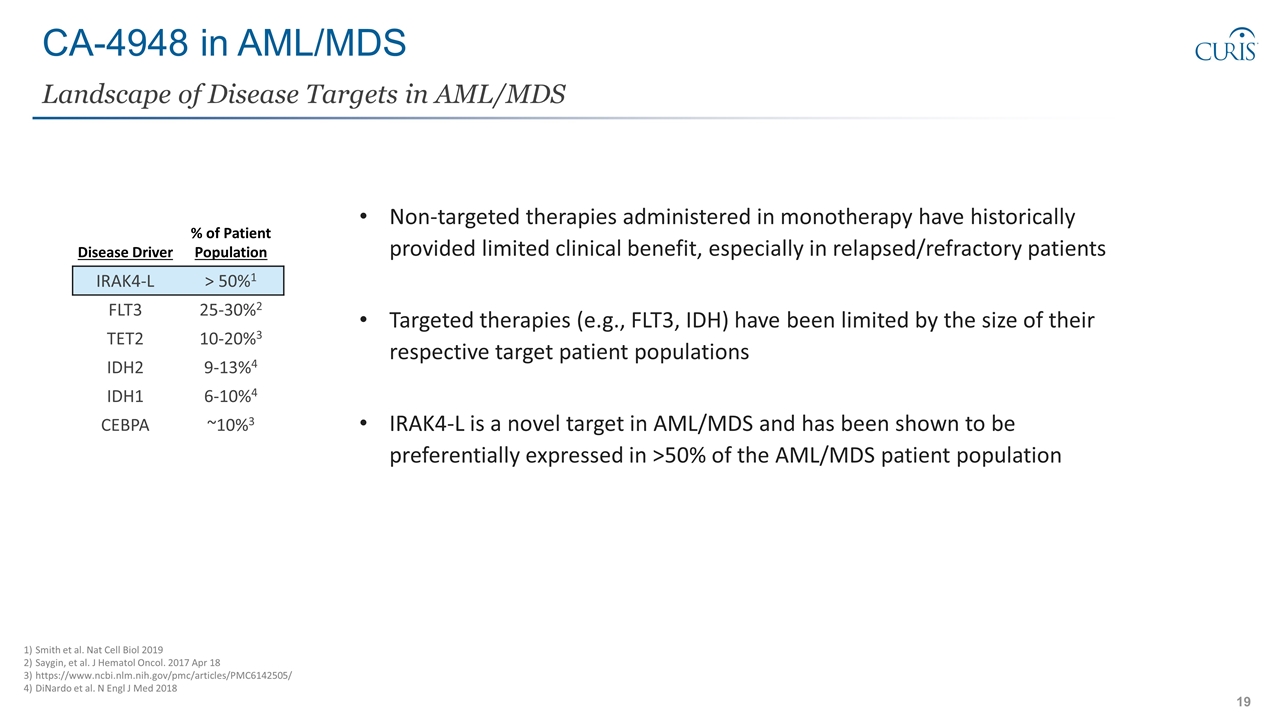
CA-4948 in AML/MDS Landscape of Disease Targets in AML/MDS Non-targeted therapies administered in monotherapy have historically provided limited clinical benefit, especially in relapsed/refractory patients Targeted therapies (e.g., FLT3, IDH) have been limited by the size of their respective target patient populations IRAK4-L is a novel target in AML/MDS and has been shown to be preferentially expressed in >50% of the AML/MDS patient population Disease Driver % of Patient Population IRAK4-L > 50%1 FLT3 25-30%2 TET2 10-20%3 IDH2 9-13%4 IDH1 6-10%4 CEBPA ~10%3 Smith et al. Nat Cell Biol 2019 Saygin, et al. J Hematol Oncol. 2017 Apr 18 https://www.ncbi.nlm.nih.gov/pmc/articles/PMC6142505/ DiNardo et al. N Engl J Med 2018
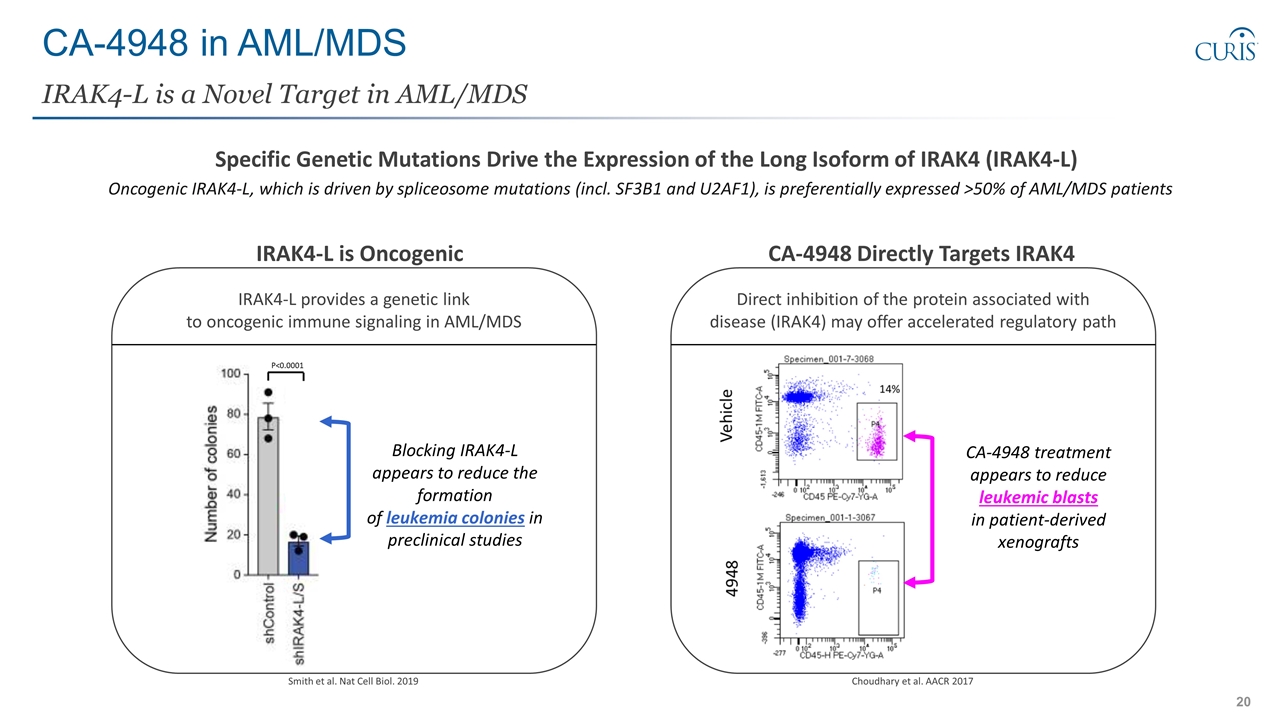
IRAK4-L provides a genetic link to oncogenic immune signaling in AML/MDS CA-4948 in AML/MDS IRAK4-L is a Novel Target in AML/MDS Specific Genetic Mutations Drive the Expression of the Long Isoform of IRAK4 (IRAK4-L) Oncogenic IRAK4-L, which is driven by spliceosome mutations (incl. SF3B1 and U2AF1), is preferentially expressed >50% of AML/MDS patients CA-4948 treatment appears to reduce leukemic blasts in patient-derived xenografts IRAK4-L is Oncogenic CA-4948 Directly Targets IRAK4 Direct inhibition of the protein associated with disease (IRAK4) may offer accelerated regulatory path Blocking IRAK4-L appears to reduce the formation of leukemia colonies in preclinical studies Smith et al. Nat Cell Biol. 2019 Choudhary et al. AACR 2017
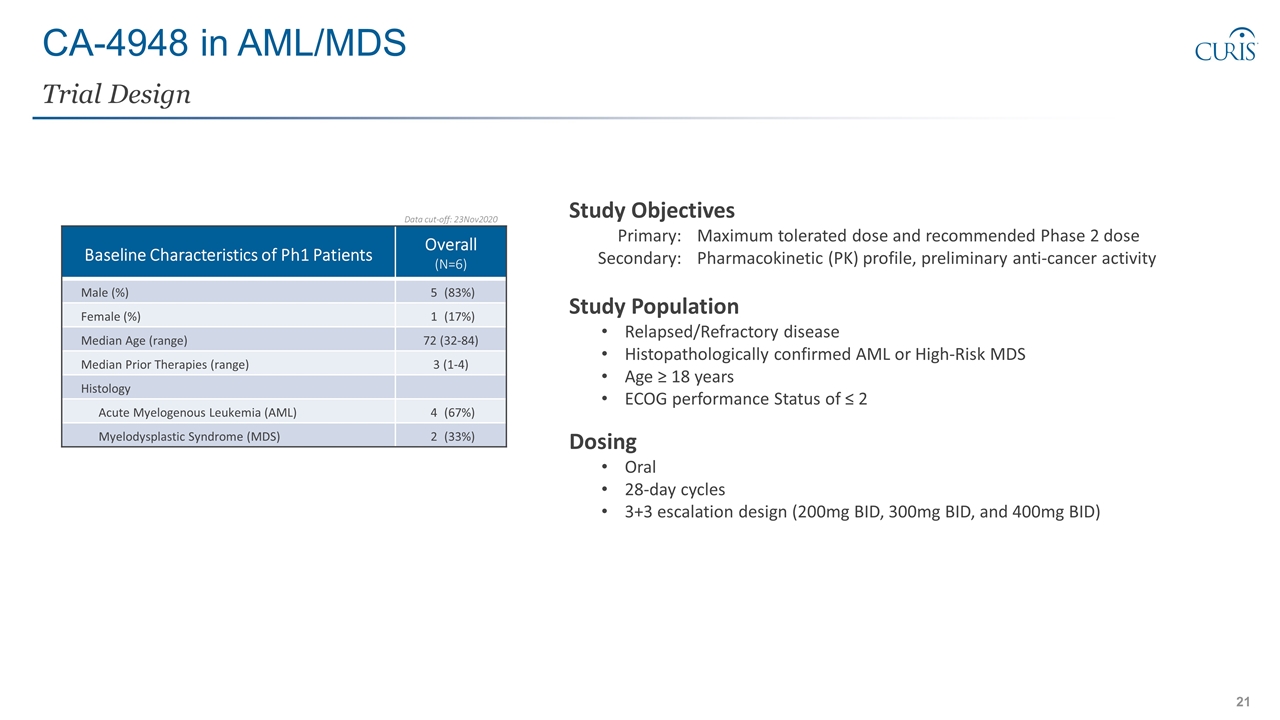
CA-4948 in AML/MDS Trial Design Study Objectives Primary: Maximum tolerated dose and recommended Phase 2 dose Secondary:Pharmacokinetic (PK) profile, preliminary anti-cancer activity Study Population Relapsed/Refractory disease Histopathologically confirmed AML or High-Risk MDS Age ≥ 18 years ECOG performance Status of ≤ 2 Dosing Oral 28-day cycles 3+3 escalation design (200mg BID, 300mg BID, and 400mg BID) Baseline Characteristics of Ph1 Patients Overall (N=6) Male (%) 5(83%) Female (%) 1(17%) Median Age (range) 72 (32-84) Median Prior Therapies (range) 3 (1-4) Histology Acute Myelogenous Leukemia (AML) 4(67%) Myelodysplastic Syndrome (MDS) 2(33%) Data cut-off: 23Nov2020
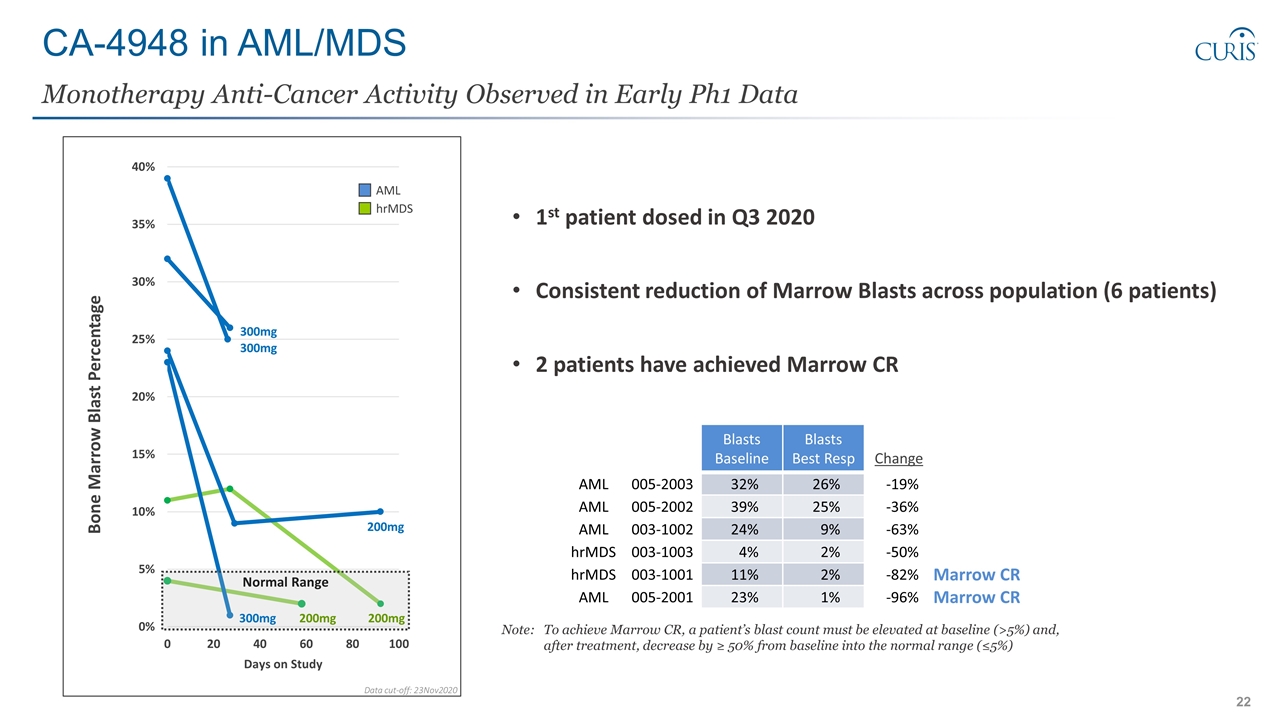
CA-4948 in AML/MDS Monotherapy Anti-Cancer Activity Observed in Early Ph1 Data Blasts Baseline Blasts Best Resp Change AML 005-2003 32% 26% -19% AML 005-2002 39% 25% -36% AML 003-1002 24% 9% -63% hrMDS 003-1003 4% 2% -50% hrMDS 003-1001 11% 2% -82% Marrow CR AML 005-2001 23% 1% -96% Marrow CR 1st patient dosed in Q3 2020 Consistent reduction of Marrow Blasts across population (6 patients) 2 patients have achieved Marrow CR 300mg 300mg 200mg Normal Range 300mg 200mg 200mg Note:To achieve Marrow CR, a patient’s blast count must be elevated at baseline (>5%) and, after treatment, decrease by ≥ 50% from baseline into the normal range (≤5%) AML hrMDS Data cut-off: 23Nov2020
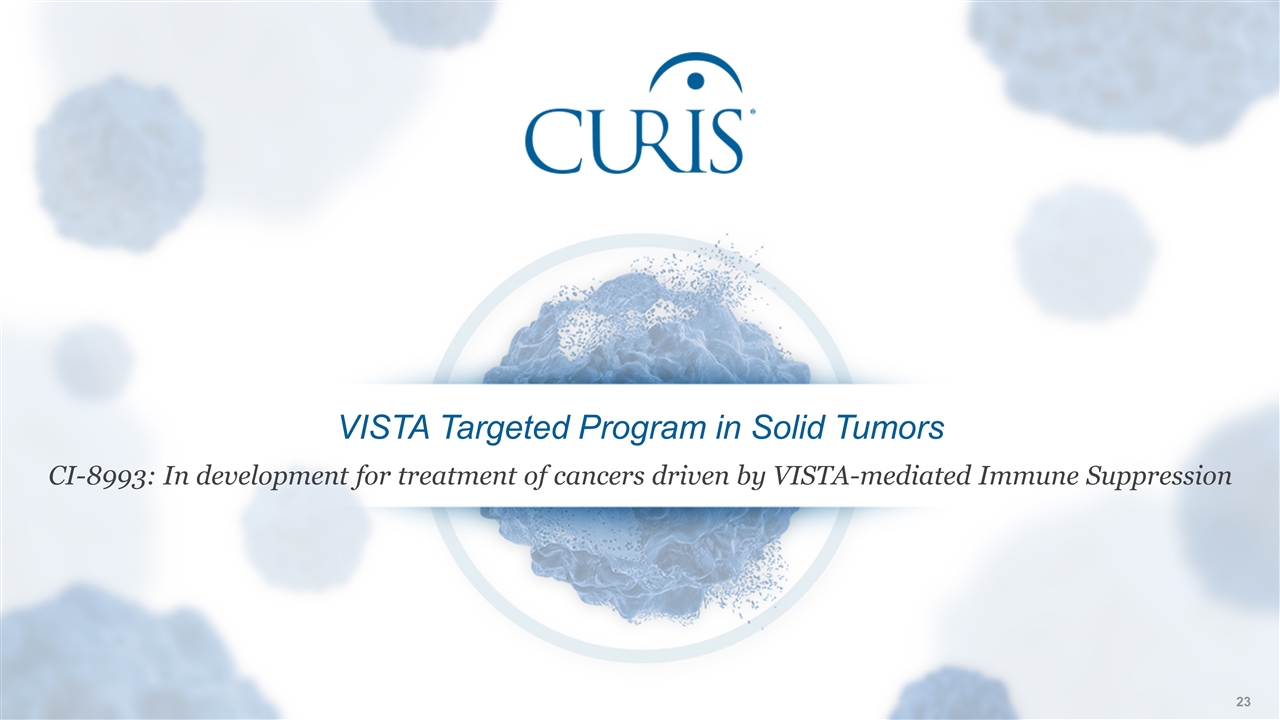
VISTA Targeted Program in Solid Tumors CI-8993: In development for treatment of cancers driven by VISTA-mediated Immune Suppression
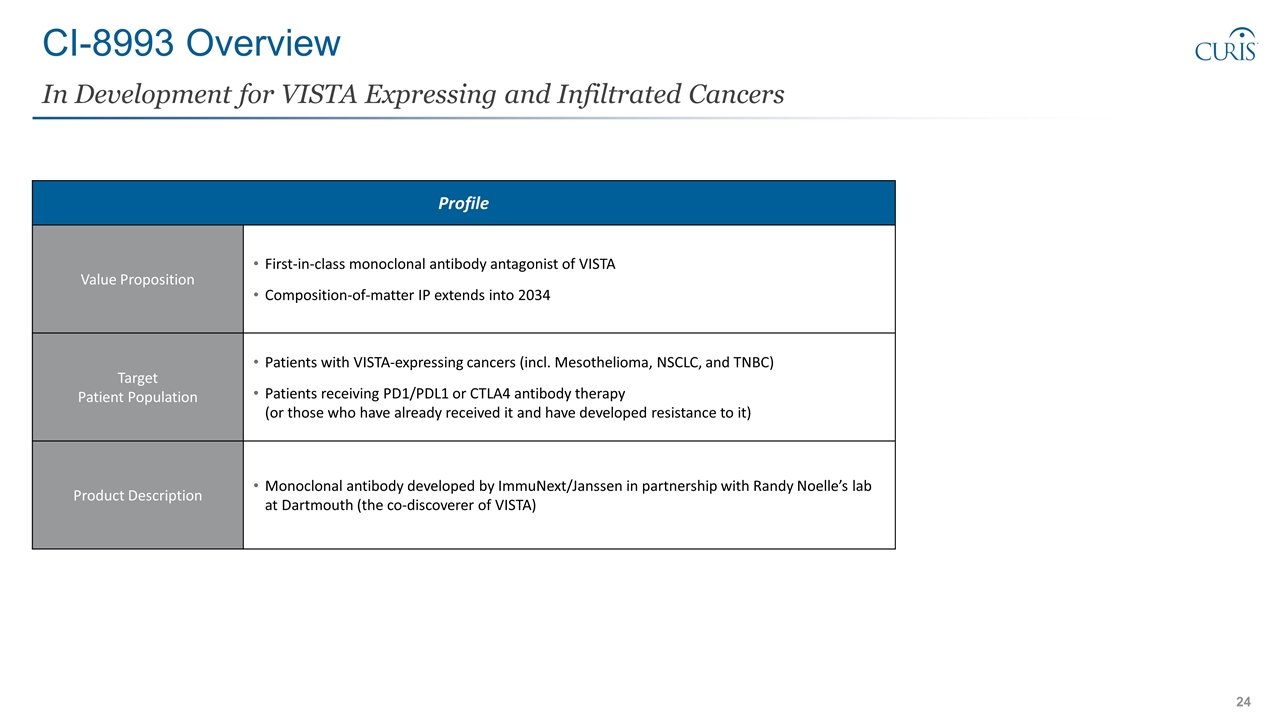
CI-8993 Overview In Development for VISTA Expressing and Infiltrated Cancers Profile Value Proposition First-in-class monoclonal antibody antagonist of VISTA Composition-of-matter IP extends into 2034 Target Patient Population Patients with VISTA-expressing cancers (incl. Mesothelioma, NSCLC, and TNBC) Patients receiving PD1/PDL1 or CTLA4 antibody therapy (or those who have already received it and have developed resistance to it) Product Description Monoclonal antibody developed by ImmuNext/Janssen in partnership with Randy Noelle’s lab at Dartmouth (the co-discoverer of VISTA) Curis is the first to advance an oral small molecule checkpoint inhibitor into the clinic
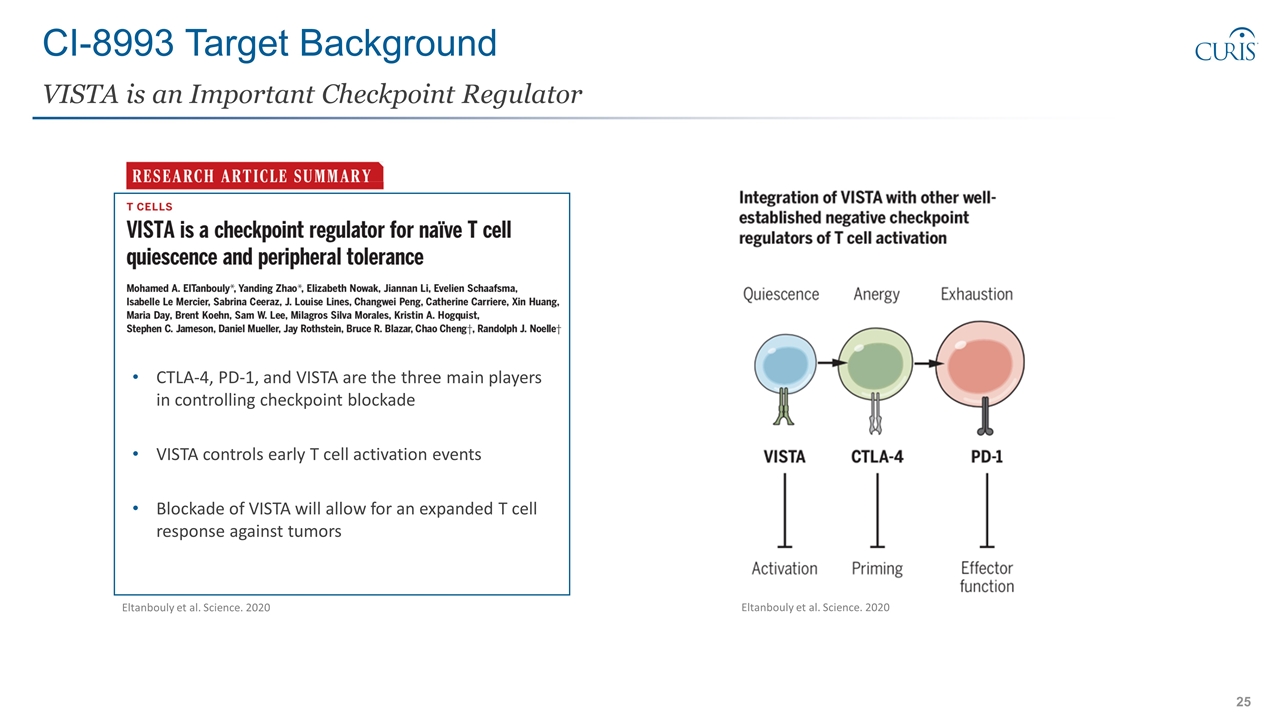
CI-8993 Target Background VISTA is an Important Checkpoint Regulator CTLA-4, PD-1, and VISTA are the three main players in controlling checkpoint blockade VISTA controls early T cell activation events Blockade of VISTA will allow for an expanded T cell response against tumors Eltanbouly et al. Science. 2020 Eltanbouly et al. Science. 2020
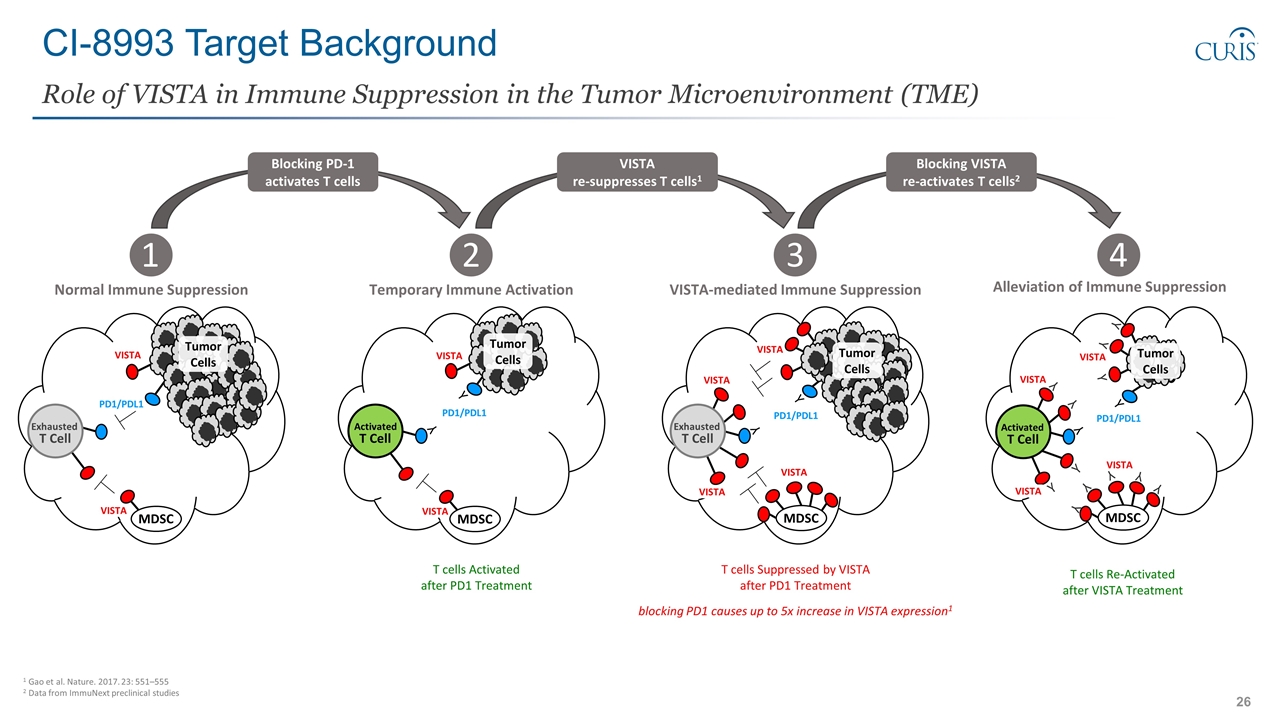
CI-8993 Target Background Role of VISTA in Immune Suppression in the Tumor Microenvironment (TME) Temporary Immune Activation ❷ MDSC T cells Activated after PD1 Treatment Y Normal Immune Suppression ❶ T Cell Exhausted MDSC Alleviation of Immune Suppression ❹ Y Y Y Y Y Y MDSC Y Y Y T cells Re-Activated after VISTA Treatment Y Y T Cell Y Y Activated Y Y VISTA-mediated Immune Suppression ❸ Y MDSC T Cell Exhausted Y Blocking PD-1 activates T cells VISTA re-suppresses T cells1 Blocking VISTA re-activates T cells2 1 Gao et al. Nature. 2017. 23: 551–555 2 Data from ImmuNext preclinical studies T cells Suppressed by VISTA after PD1 Treatment blocking PD1 causes up to 5x increase in VISTA expression1 PD1/PDL1 Tumor Cells VISTA VISTA VISTA VISTA Tumor Cells PD1/PDL1 VISTA VISTA VISTA VISTA VISTA VISTA VISTA VISTA Y Tumor Cells T Cell Activated Y PD1/PDL1 PD1/PDL1 Tumor Cells
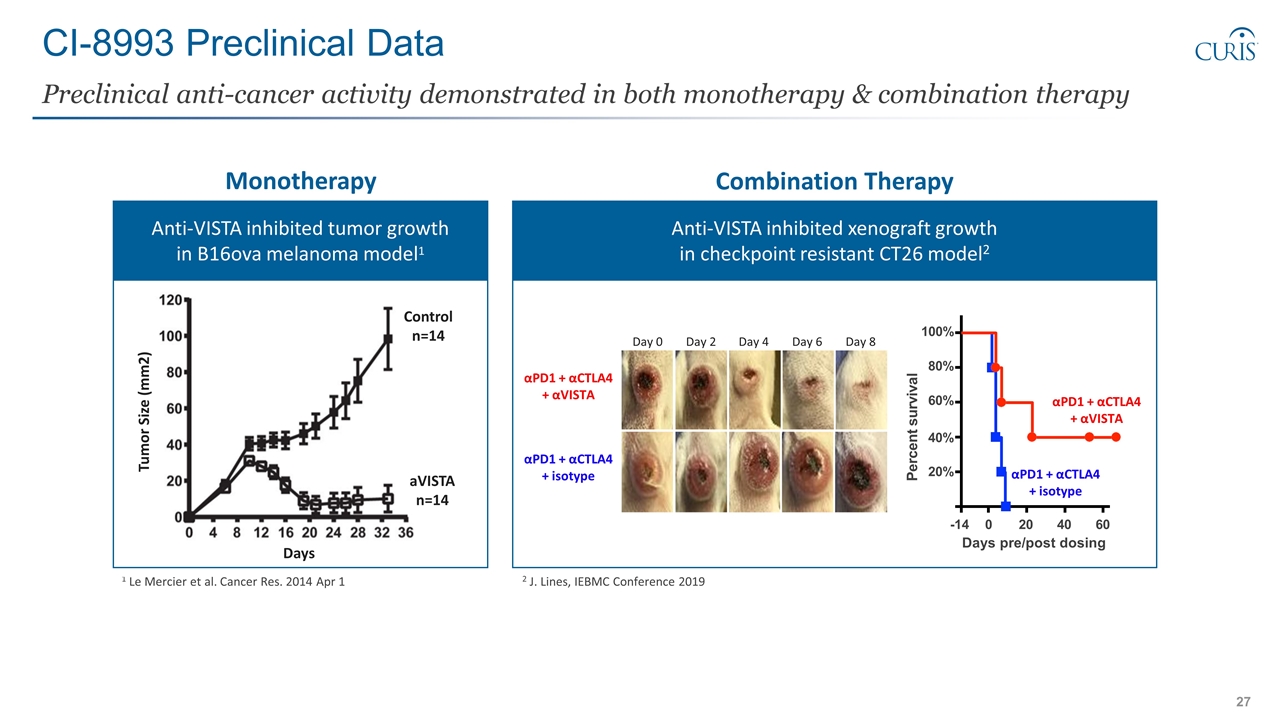
αPD1 + αCTLA4 + αVISTA αPD1 + αCTLA4 + isotype CI-8993 Preclinical Data Preclinical anti-cancer activity demonstrated in both monotherapy & combination therapy 1 Le Mercier et al. Cancer Res. 2014 Apr 1 Anti-VISTA inhibited tumor growth in B16ova melanoma model1 Anti-VISTA inhibited xenograft growth in checkpoint resistant CT26 model2 Monotherapy Combination Therapy Day 0 Day 2 Day 4 Day 6 Day 8 Control n=14 aVISTA n=14 Days Tumor Size (mm2) 80% 100% Days pre/post dosing Percent survival -14 0 20 40 60 αPD1 + αCTLA4 + αVISTA αPD1 + αCTLA4 + isotype 2 J. Lines, IEBMC Conference 2019 60% 40% 20%
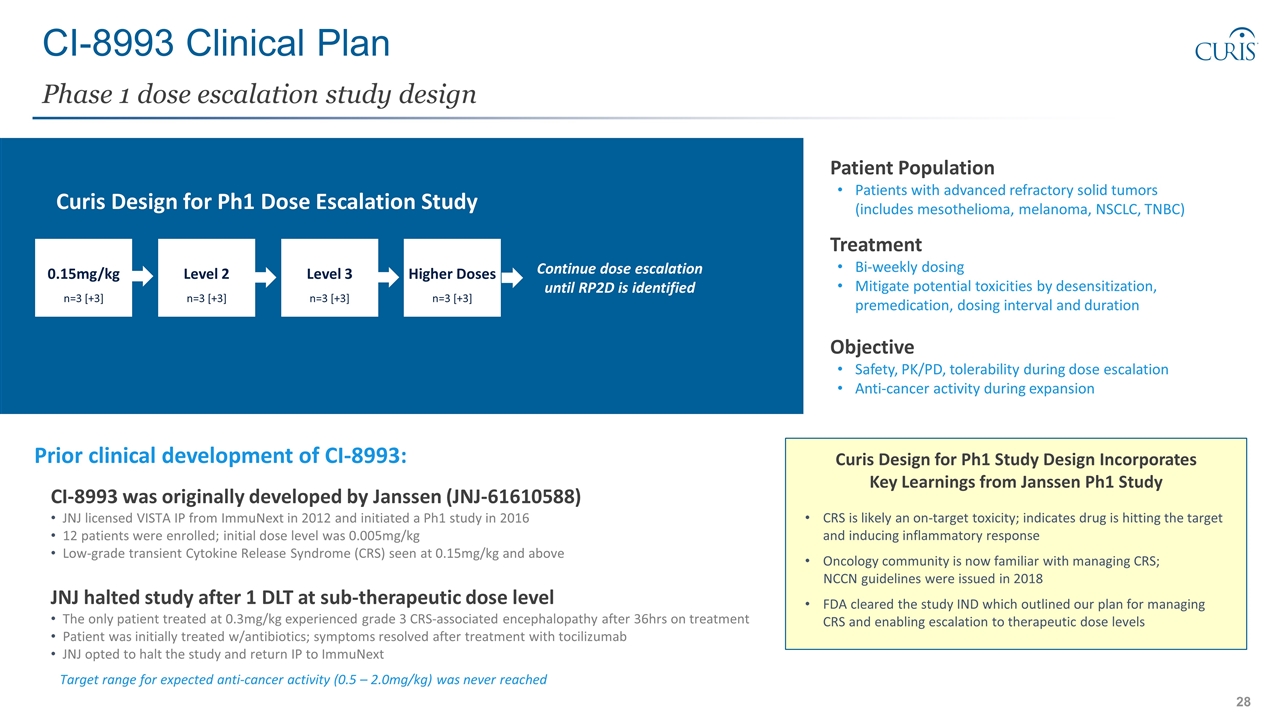
CI-8993 Clinical Plan Phase 1 dose escalation study design Patient Population Patients with advanced refractory solid tumors (includes mesothelioma, melanoma, NSCLC, TNBC) Treatment Bi-weekly dosing Mitigate potential toxicities by desensitization, premedication, dosing interval and duration Objective Safety, PK/PD, tolerability during dose escalation Anti-cancer activity during expansion CI-8993 was originally developed by Janssen (JNJ-61610588) JNJ licensed VISTA IP from ImmuNext in 2012 and initiated a Ph1 study in 2016 12 patients were enrolled; initial dose level was 0.005mg/kg Low-grade transient Cytokine Release Syndrome (CRS) seen at 0.15mg/kg and above JNJ halted study after 1 DLT at sub-therapeutic dose level The only patient treated at 0.3mg/kg experienced grade 3 CRS-associated encephalopathy after 36hrs on treatment Patient was initially treated w/antibiotics; symptoms resolved after treatment with tocilizumab JNJ opted to halt the study and return IP to ImmuNext Prior clinical development of CI-8993: Target range for expected anti-cancer activity (0.5 – 2.0mg/kg) was never reached Continue dose escalation until RP2D is identified Higher Doses n=3 [+3] Level 3 n=3 [+3] Level 2 n=3 [+3] 0.15mg/kg n=3 [+3] Curis Design for Ph1 Dose Escalation Study Curis Design for Ph1 Study Design Incorporates Key Learnings from Janssen Ph1 Study CRS is likely an on-target toxicity; indicates drug is hitting the target and inducing inflammatory response Oncology community is now familiar with managing CRS; NCCN guidelines were issued in 2018 FDA cleared the study IND which outlined our plan for managing CRS and enabling escalation to therapeutic dose levels
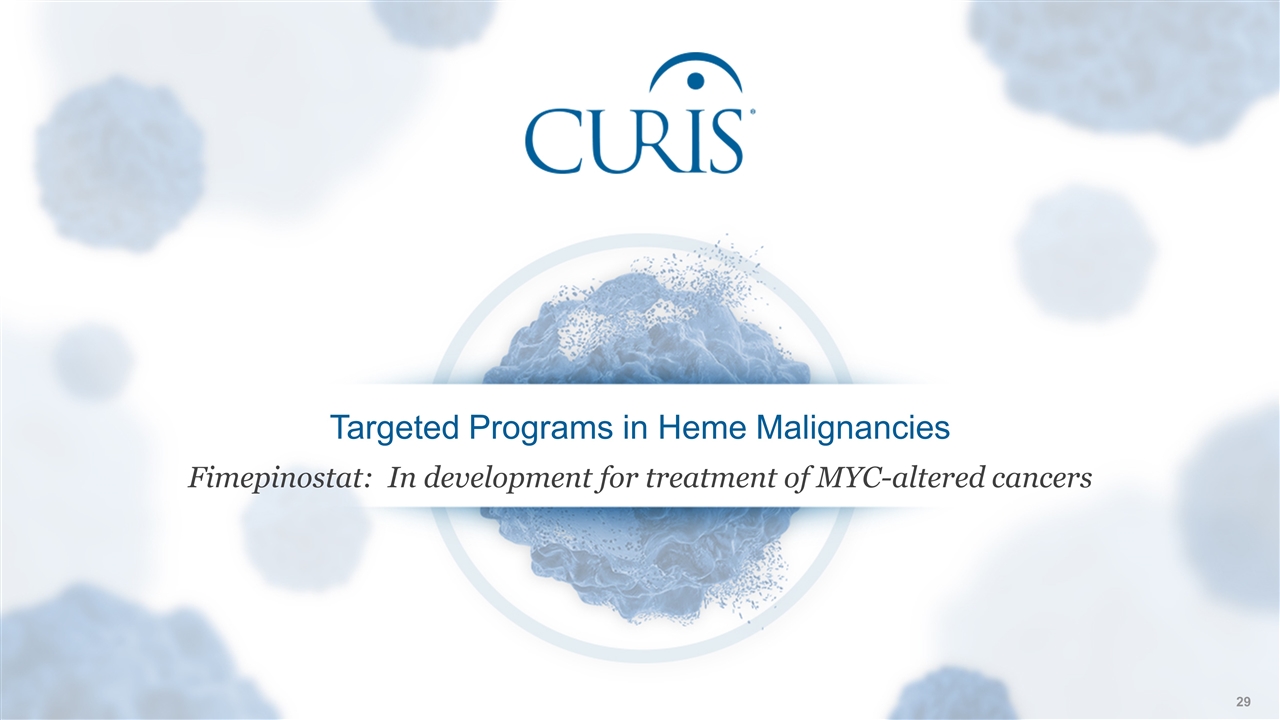
Targeted Programs in Heme Malignancies Fimepinostat: In development for treatment of MYC-altered cancers
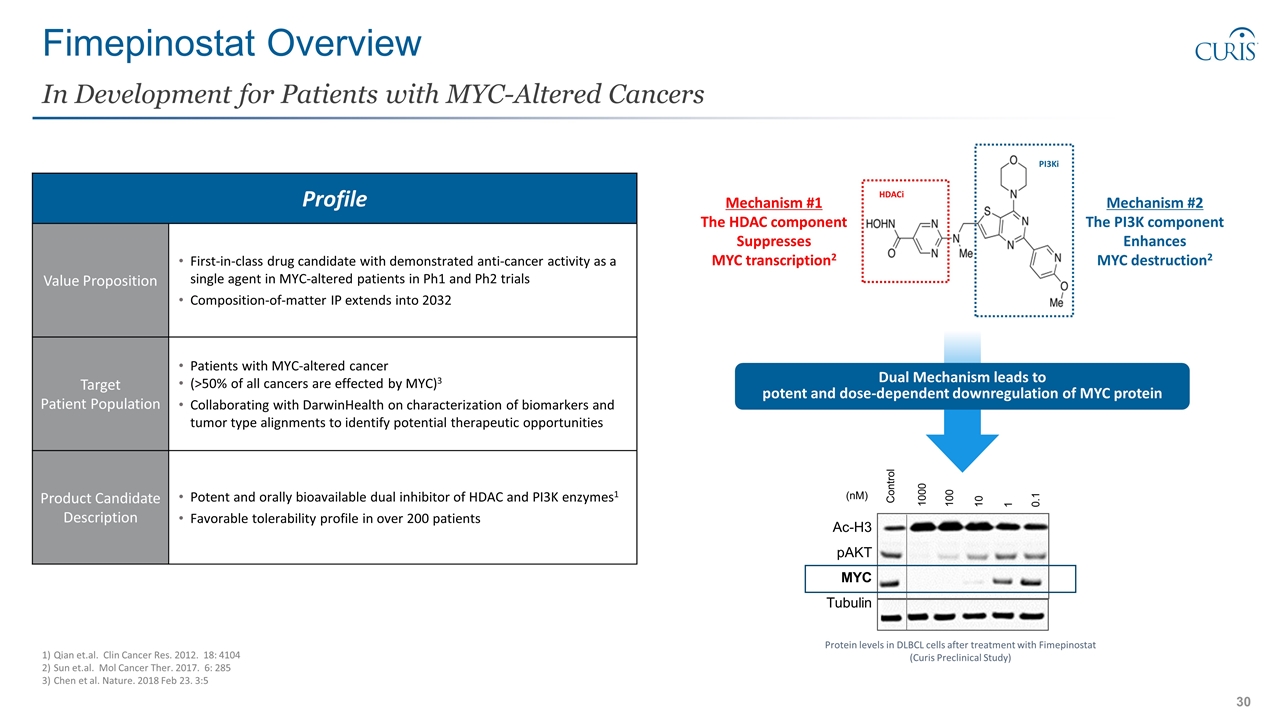
Fimepinostat Overview In Development for Patients with MYC-Altered Cancers Qian et.al. Clin Cancer Res. 2012. 18: 4104 Sun et.al. Mol Cancer Ther. 2017. 6: 285 Chen et al. Nature. 2018 Feb 23. 3:5 Profile Value Proposition First-in-class drug candidate with demonstrated anti-cancer activity as a single agent in MYC-altered patients in Ph1 and Ph2 trials Composition-of-matter IP extends into 2032 Target Patient Population Patients with MYC-altered cancer (>50% of all cancers are effected by MYC)3 Collaborating with DarwinHealth on characterization of biomarkers and tumor type alignments to identify potential therapeutic opportunities Product Candidate Description Potent and orally bioavailable dual inhibitor of HDAC and PI3K enzymes1 Favorable tolerability profile in over 200 patients HDACi PI3Ki Mechanism #1 The HDAC component Suppresses MYC transcription2 Mechanism #2 The PI3K component Enhances MYC destruction2 Protein levels in DLBCL cells after treatment with Fimepinostat (Curis Preclinical Study) Control 1000 100 10 1 0.1 Ac-H3 pAKT MYC Tubulin (nM) Dual Mechanism leads to potent and dose-dependent downregulation of MYC protein
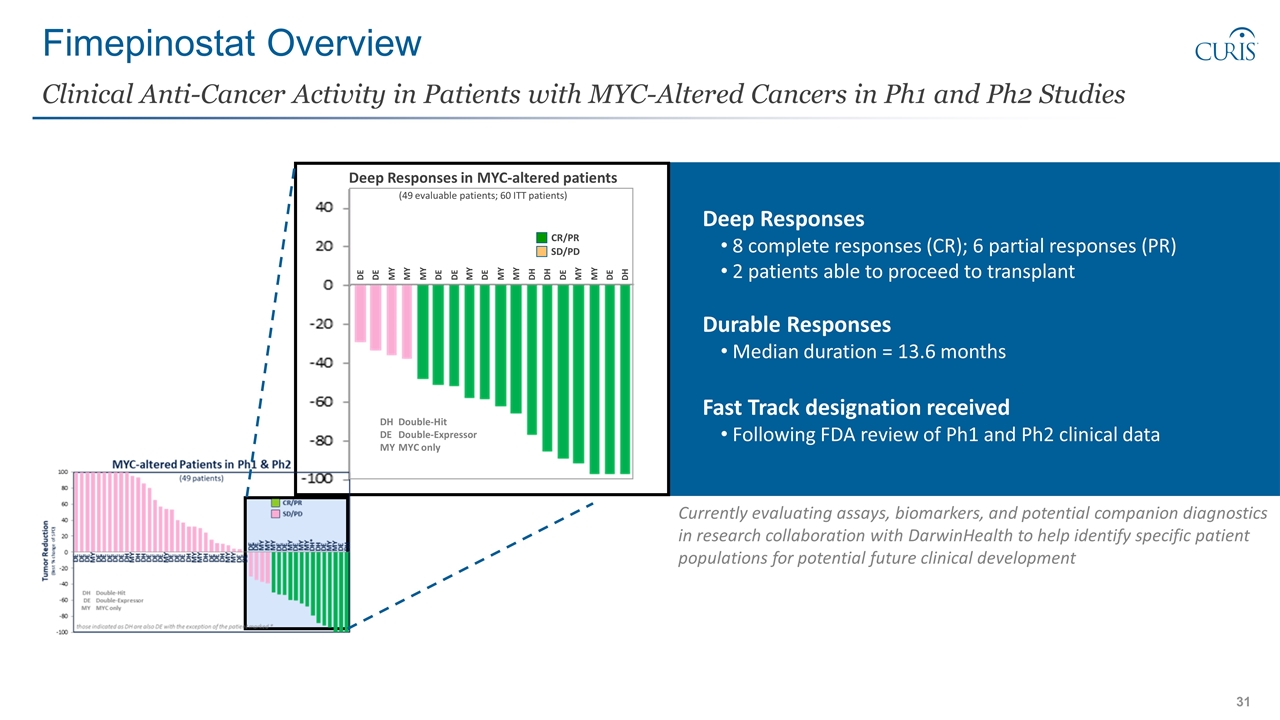
Fimepinostat Overview Clinical Anti-Cancer Activity in Patients with MYC-Altered Cancers in Ph1 and Ph2 Studies Deep Responses 8 complete responses (CR); 6 partial responses (PR) 2 patients able to proceed to transplant Durable Responses Median duration = 13.6 months Fast Track designation received Following FDA review of Ph1 and Ph2 clinical data CR/PR DH DE DE DH DH DE DE DE DE MY MY MY MY MY MY MY MY DE DHDouble-Hit DEDouble-Expressor MYMYC only SD/PD Deep Responses in MYC-altered patients (49 evaluable patients; 60 ITT patients) Currently evaluating assays, biomarkers, and potential companion diagnostics in research collaboration with DarwinHealth to help identify specific patient populations for potential future clinical development
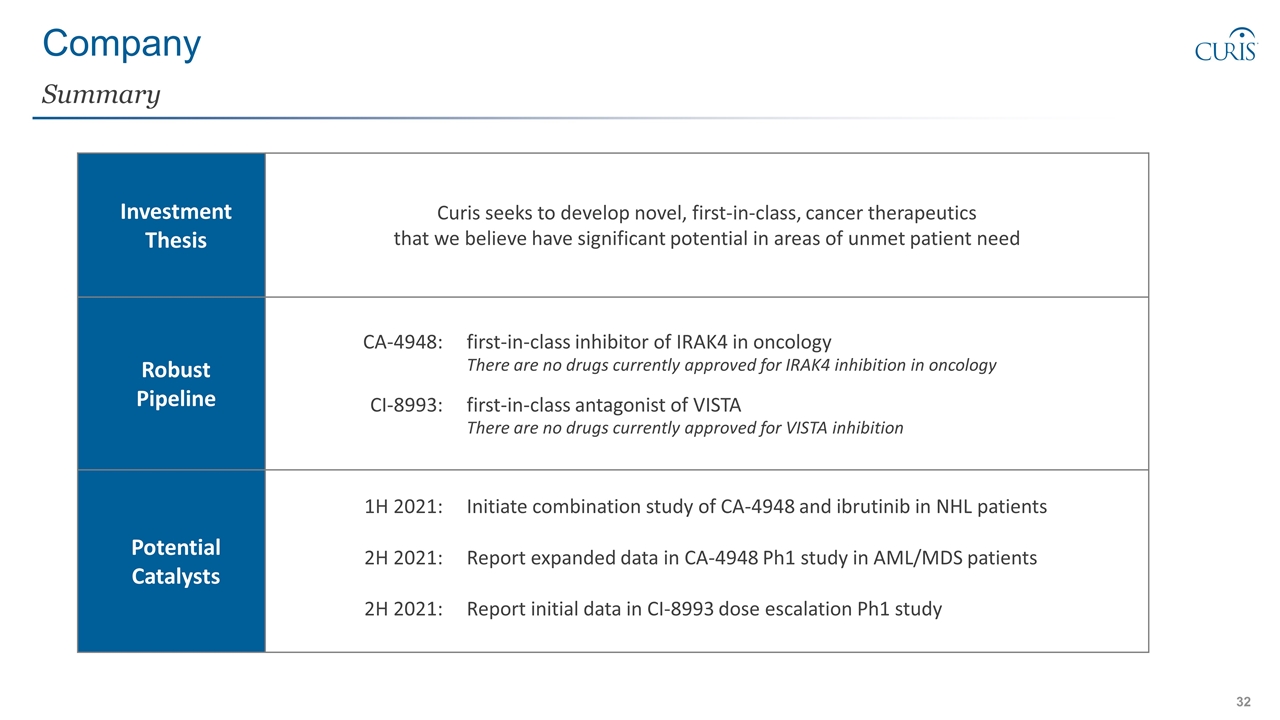
Company Summary Investment Thesis Curis seeks to develop novel, first-in-class, cancer therapeutics that we believe have significant potential in areas of unmet patient need Robust Pipeline CA-4948:first-in-class inhibitor of IRAK4 in oncology There are no drugs currently approved for IRAK4 inhibition in oncology CI-8993:first-in-class antagonist of VISTA There are no drugs currently approved for VISTA inhibition Potential Catalysts 1H 2021:Initiate combination study of CA-4948 and ibrutinib in NHL patients 2H 2021:Report expanded data in CA-4948 Ph1 study in AML/MDS patients 2H 2021:Report initial data in CI-8993 dose escalation Ph1 study

Curis Leadership Team Reinhard von Roemeling Head, Clinical Development Raul Soikes Head, Portfolio Management Nancy Soohoo General Counsel William Steinkrauss Chief Financial Officer Mark Noel Head, Intellectual Property Rachel Blasbalg Head, Human Resources James Dentzer President & CEO Christine Guertin Head, Regulatory Robert Martell Head, R&D
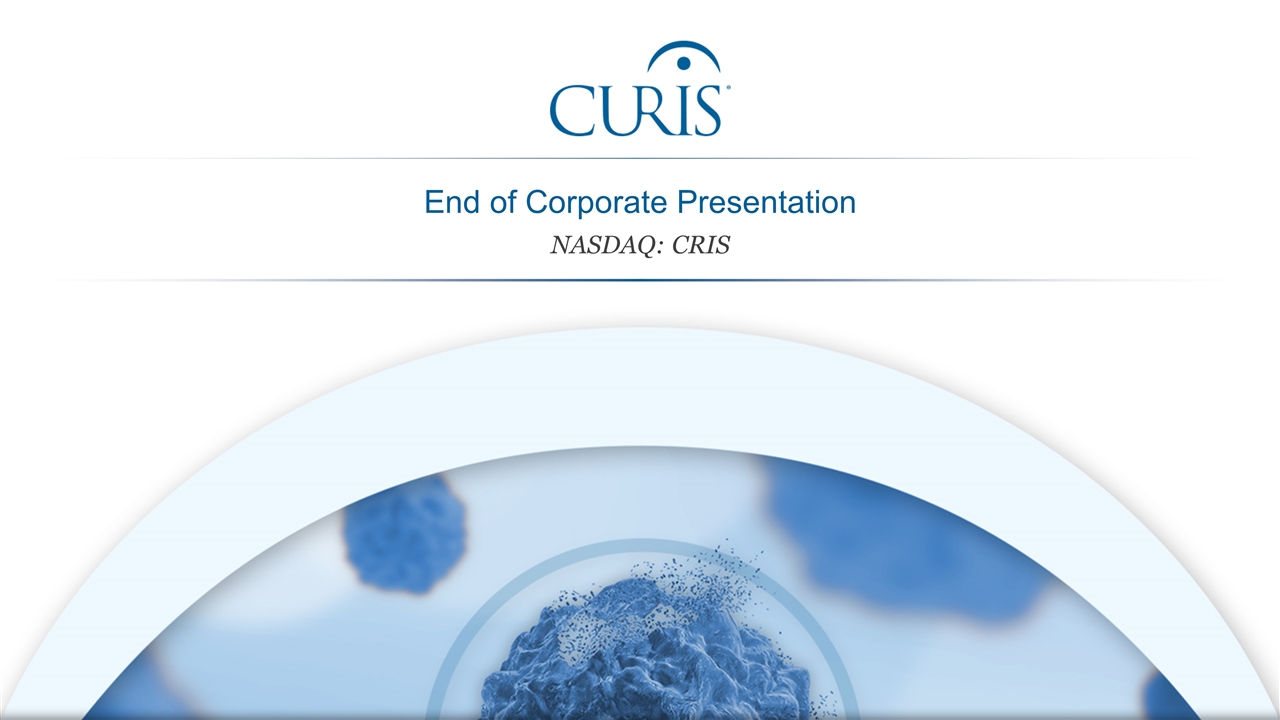
End of Corporate Presentation NASDAQ: CRIS

































